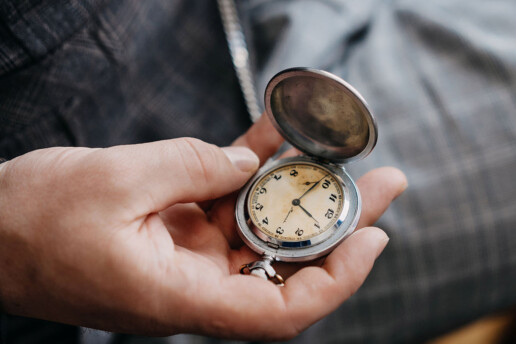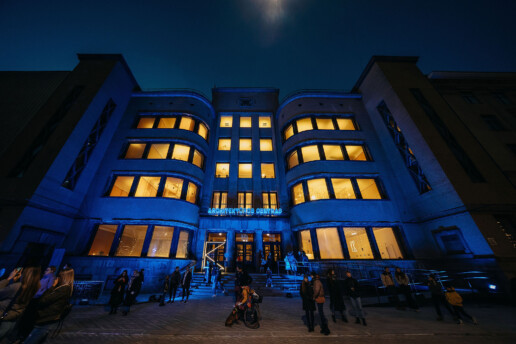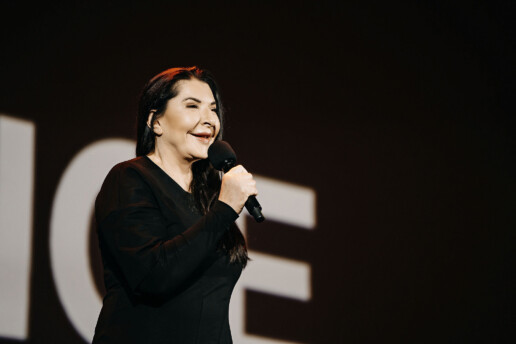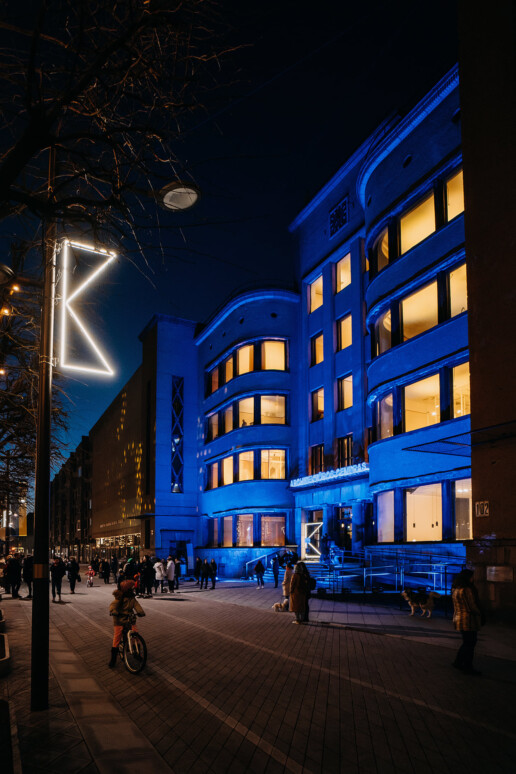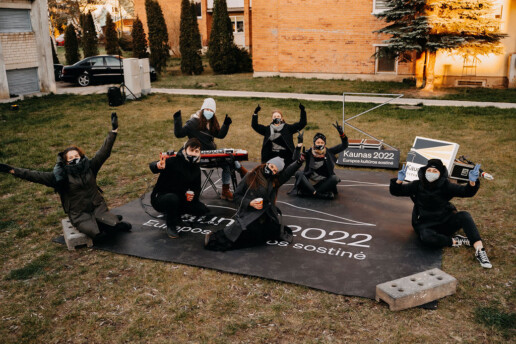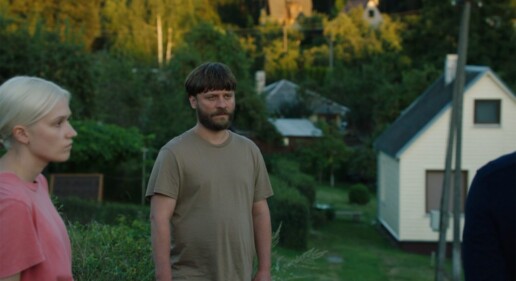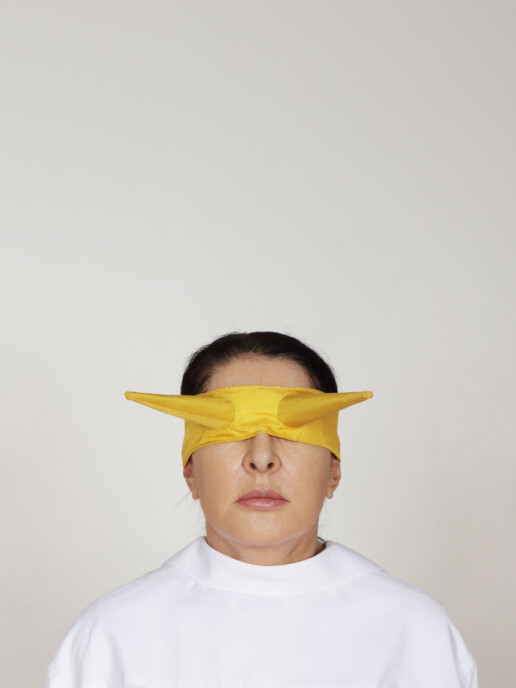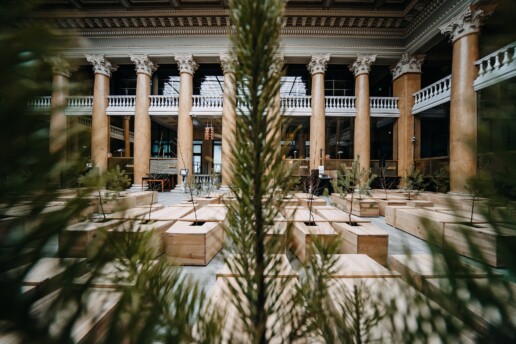Kaunas Modernist Architecture-inspired Film to Debut in Canada
2022-04-08Aktualijos,News,media-news
Directed by Aideen Barry, “Folds/Pleats”, presenting the modernist architecture of Kaunas, Lithuania and dedicated to the year of European Capital of Culture Year of Culture, is starting its festival journey. On April 10, the film will be screened for the first time in Canada at The Architecture + Design Film Festival (A+DFF) in Winnipeg.
The annual film event showcases critically acclaimed films focusing on the importance of architecture and design in everyday life. The festival presents a wide range of design-oriented topics from architecture and the city to graphic and product design.
It was the year 2019 when the Kaunas 2022 team decided to make sense of the modernist architecture awaiting UNESCO recognition in a unique film. The renowned Irish artist Aideen Barry, the winner of the prestigious Golden Fleece Award, whose work is exhibited in museums, contemporary art centres and private galleries worldwide, was invited to implement the idea.
The film was made through an unusual process. The artist’s creative practice is based on community involvement: the plot is based on the stories told by the citizens, and the residents of Kaunas become characters in the film. The surrealistic “Folds/Pleats” combines the city’s heritage, history, and its people’s fictional novels.
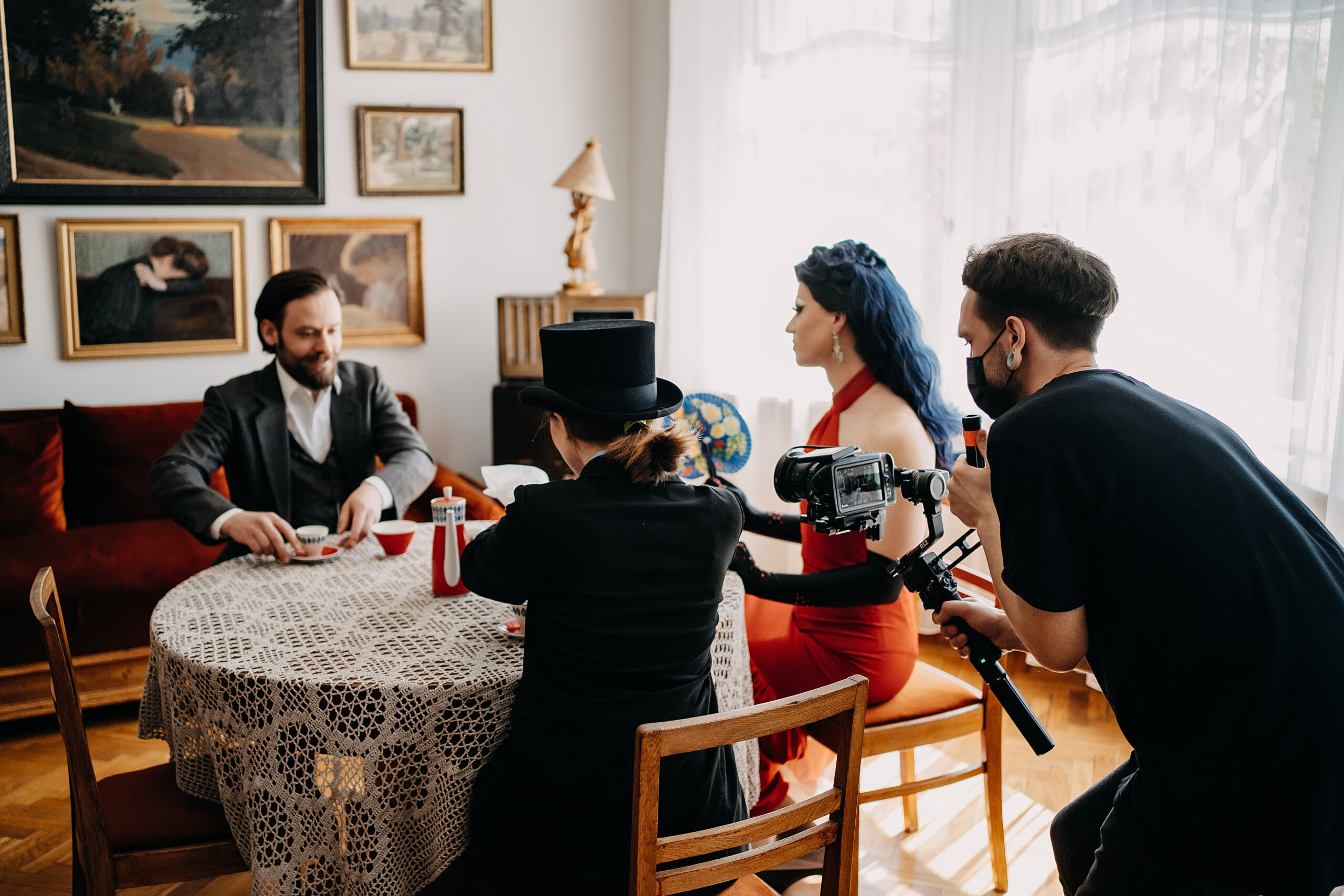
The title of the architectural film is a metaphor for the recurring elements in interwar architecture and the creative process itself: the plot is folded from thousands of photographs. Stories fold between stories, buildings between buildings. The viewers, together with the characters, peek into the interiors of the buildings, marvel at the typical rounded windows of Kaunas and the elegant staircase doors, and gaze at the ceiling as if lying on a carpet with a cigar smouldering in between his fingers.
“With the whole creative team, we waited long and anxiously to see which international festival would host the first screening. It is incredible that the magical story of Kaunas Modernism is travelling so far away, to another continent, to Winnipeg in Canada. We are thrilled,” says Viltė Migonytė-Petrulienė, the Modernism for the Future programme curator.
Link to the trailer
Lithuanian audiences will be able to see the architecture film in cinemas later this year. The first screening is scheduled for 21 September 2022 in the place where the film was born, Kaunas, at the newly renovated historical Romuva Cinema. It will then travel to cinemas across Lithuania.
The film was initiated and supported by the Kaunas - European Capital of Culture 2022 programme Modernism for the Future.
Trailer: https://www.youtube.com/watch?v=JGgDVpe00vk
Photo author Martynas Plepys
The European Capital of Culture Forum to Adress the Legacy of Kaunas 2022 and the Preservation of Free Europe
2022-04-06Aktualijos,News,media-news
As spring is gathering pace, the most dynamic season of the Kaunas 2022 programme is upon us. However, the year of the European Capital of Culture (ECoC) is drawing to a close with each passing day.
What should the Kaunas city and Kaunas region expect after 2022? Will the cultural life continue in the same rhythm? What can we do today to ensure the continuity of communities’ and artists’ initiatives? These and other questions will be raised and answered in discussions and informal conversations at the fifth European Capital of Culture Forum, scheduled for 19 May this year. The theme of this year’s event is “Legacy”.
This year’s European Capital of Culture Forum will occur during a very intense cultural programme and will mark the weekend of “Santaka” (Confluence), the second major event of the Contemporary Kaunas Myth trilogy. As every year, the Forum’s main aim is to raise the professionalism and vigour of the cultural sector, reminding each other how culture contributes to the development of cities and regions.
The international event, which started as one of the initial events by the team of Kaunas 2022, has over the years become an essential platform and opportunity for past, present and future ECoC teams and representatives of cultural institutions operating at the European level to meet. And, of course for cultural operators, artists, businesses, researchers, event participants - those without whom neither the Forum nor the whole ECoC programme would be valid.
“The European Capital of Culture project was planned for five years ahead, as a continuous learning and creative process. The Forum has been feeding the project and the cultural community with visions and ideas that we drew from other Capitals of Culture, and more and more from the local cultural field over time. Today, we are halfway through the Capital of Culture year and as the project reaches the finish line, the question is: what next? What vision will we have at the end of this year? What will remain after the project ends? To this end, the Forum will look at the experiences of other European Capitals of Culture, discuss the impact and sustainability of the Kaunas - European Capital of Culture project, as well as how to preserve the project's strongest asset - the active co-creation of communities and the cultural network,” says Ana Kočegarova-Maj, Head of Programme of Kaunas 2022 and curator of the European Capital of Culture Forum.

Kočegarova-Maj hopes that, as every year, the Forum will provide participants with an experience of fellowship and an opportunity to be part of a wide circle of cultural players: “Without help and struggle, the best thing we can do in the face of war is to stay calm and do our job, building a resilient society and strong ties between them. That is why I am particularly pleased that the live circle of participants will be joined by close colleagues from the Lviv Institute for Cultural Strategy, who are the purest example of cultural activism and community mobilisation.“
Immie Jonkmann from Leeuwarden 2018 (The Netherlands), Beatriz Gracia, Senior Research Fellow at the University of Liverpool and Associate Director of the Centre for Cultural Property (UK), among others, have already been confirmed as participants in the European Capital of Culture forum.
The most pressing topic on the minds of professionals in all fields at the moment is the ongoing war in Ukraine. It is a topic that raises the difficult question: how do we preserve a free Europe? That is why a special session of the Forum will be dedicated to the war. A conversation with Yulia Khomchyn, Member of the Lviv City Council, Director of the Institute of Contemporary Art and Head of the Lviv Institute for Cultural Strategy, will focus on the latest developments and how Ukraine can be assisted.
Agata Etmanowicz (President of Impact Foundation, Poland), already well known to many people in the cultural field of Kaunas, will moderate a session on the long-term impact of the capacity building programme and audience development. She is positive that 2022 is (just) a stop on the way, not a final destination: “We are going to summarise the Audience Development Programme for Kaunas 2022 with all its ups and downs and through different perspectives. The storytellers will be organisers, individual participants, organisations and institutions. There will also be a chance to exchange experiences with Rijeka 2020. To conclude, we will also look at the scenarios for the future.”
Among the Lithuanian participants is sociologist Tadas Šarūnas, who is currently conducting an external evaluation of Kaunas 2022. “In our quest for socially and economically powerful cultural policies, we seem to have forgotten to observe the very bases on which this power stands. I will be inviting to come back to observations of everyday life. After all, this is a scene where cultural interactions make their healing touch,” he invites.
Roberto Magro (Italy/Spain) and Džiugas Kunsmanas (Lithuania) will be presenting their magical experiences in the Kaunas district. They will reflect on the foreseeable and unpredictable impacts of their artistic work in the communities of Linksmakalnis, Mastaičiai, Neveronys, and Bubiai. They describe their experience as “creating territories of lived and imaginary poetry”.
The Forum will also look at the impact of the ECoC - not only the numbers in the reports but also the profound changes and the theme of the future after Kaunas 2022. Questions that make sense to ask now are what results, at the social and cultural level, have been achieved by Kaunas and the other ECoC and what measures can be taken to maintain a sustainable continuity of such impact.
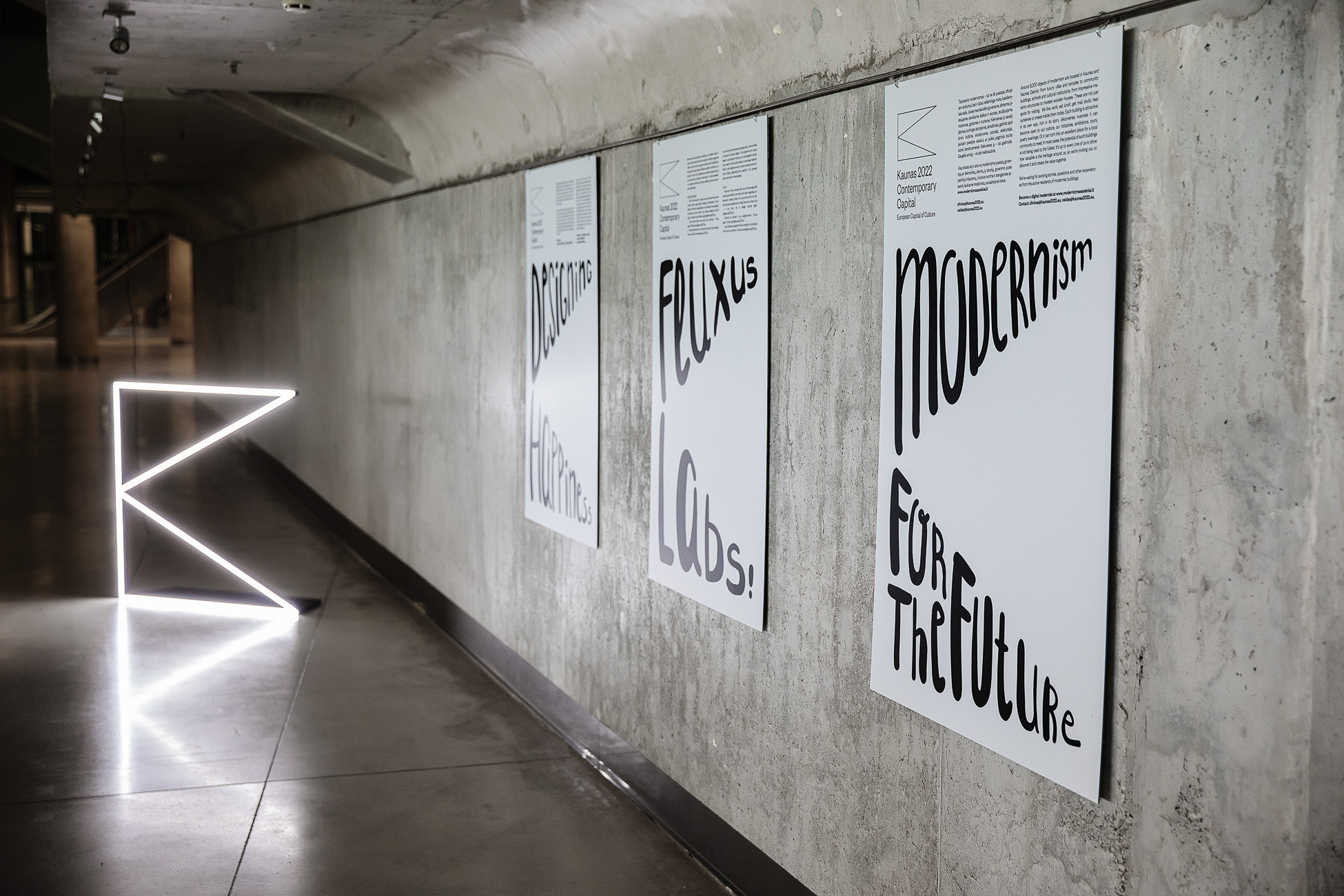
Of course, it is crucial to define the legacy, and the Forum will also allow time for this. There will be an opportunity to discuss the footprints of the Capital of Culture on cultural life - its intensification, new festivals and initiatives, innovative practices, and increased cooperation between institutions. It is also about more culturally active neighbourhoods and districts, more vibrant community contacts, changing and purifying identities of the city and the district, and an altered perception of historical events and heritage. The Forum will also look at the examples of other capitals - what results have been achieved in other cities and what measures have helped prevent the loss of heritage.
The Forum will take place on 19 May at Žalgirio Arena in Kaunas, Lithuania.
Registration: https://forms.gle/TnssBVgio1AeVLf29
Programme: https://forumas.kaunas2022.eu
Photo author Martynas Plepys
OPTIMISMO Festival in Kaunas Aims at Strengthening the Link Between the Urban Past and the Sounds of the Future
2022-04-05Aktualijos,Current Issues,News,media-news
OPTIMISMO is a new electronic and experimental music event that will take place in Kaunas, in a former industrial quarter and other sites in the city on 3-5 June 2022. It is presented by Kaunas - European Capital of Culture 2022 and its Modernism for the Future programme, which aims to activate an emotional connection with the past and its monuments that have survived to this day.
How can we talk about positive things when the world around us is turning upside down, ideals are falling apart, meanings are changing, and we can no longer communicate? In the 19th century Bialystok, a melting pot of nations, the Polish-born Litvak Ludwik Lazaris Zamenhof searched for very similar answers. In his environment, conflicts between the ethnic groups living there broke out almost every day - the boy understood early on what happens when people cannot get along because they don’t talk to each other.
It was the idea of Esperanto, created by a man who also lived in Kaunas, that became the springboard for the creation of the city’s new festival OPTIMISMO, where the historical past and industrial heritage interact harmoniously with contemporary experimental and electronic music that is soaked with future. The optimism was shared between the Esperanto linguist and the creators of Kaunas, a city that grew sevenfold before WW2, and the belief in a more prosperous, friendlier future.

Optimism as a way to Move Forward
Kaunas’ fast pace a century ago was driven by the ambition to build a better, more vibrant and exciting future. To build with a fresh and functional modernist approach. Times have changed, and concepts of the present and the future have changed, but optimism is still perhaps the only thing that holds our collective consciousness. The festival organisers were indeed inspired by the cultural phenomenon described extensively by historian Marija Drėmaitė and colleagues in the exhibition and the accompanying book bearing the same name.
OPTIMISMO is a joint creation of two Lithuanian electronic music organisations - Digital Tsunami, which curates international events and the label of the same name, and Ghia, which finds inspiration in the industrial body of Kaunas.
“Writing about music is as difficult as dancing about architecture,” a phrase attributed to many creators, also found a place in the thinking about the OPTIMISMO programme, its setting and the artists who will come to the European Capital of Culture from many countries across Europe and the world, including Lithuania. The musical programme of the event will bring together different experiences and invite one to participate, listen and grow your understanding of sound, space and technological possibilities.
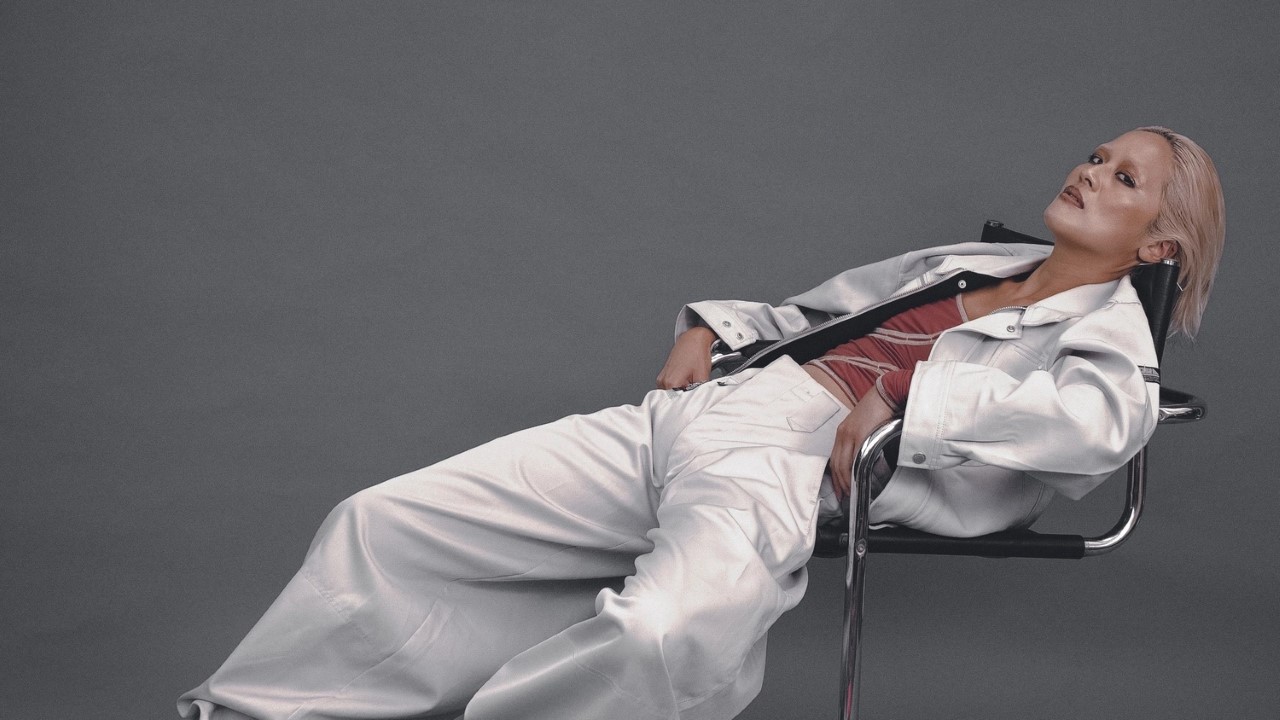
Guests of OPTIMISMO and their urban stories
Every piece of art and its creator is inseparable from a context. Thus the guests of OPTIMISMO are presented to the public not just by short musical biographies but also by their relationship with homelands and other urban contexts.
We are looking forward to discussing the importance and meaning of colonial architectural heritage, namely cinemas, in Angola with Nazar, who returned to his native country only when the 27-year Angolan civil war ended in 2002. The artist’s creative world centres around the extreme violence, injustice and omnipresence of a repressive state during and after the, while exploring hope, resilience and pride in a country torn apart by conflict.
Just as modernist architecture became an optimistic way of life and growth for Kaunas, the new yet temporary capital of reborn Lithuania, after WW1, a similar process took place in the Philippines a couple of decades later, after WW2. In the post-colonial period, the Filipino architects not only took on the pure surfaces and precise forms of modern architecture but infused the structural decisions with national elements. Thus, globally recognised architecture that still bears the national spirit is indeed a common thing between the Philippines and Lithuania.
Interestingly enough, Corin, the Filipina-Australian electronic producer, composer and performer working in performance art, sound design, theatre and club spaces, has become interested in her cultural connections to the Philippines, her mother’s birthplace and the landscape connected to it. “I’ve already begun to hear how it influences my creative output. Over the next year, I hope to produce an entire album which explores this connection”, said Corin in her recent interview with 15questions.
Yet another guest of OPTIMISMO is based in Shanghai. Osheyack is an integral member of the city’s electronic music scene that centres around ALL Club. The venue itself is located in a fascinating area near Changle Lu, a historic road in what was the French Concession between 1849 and 1943. In the 1920s, it was considered a premier residential area of Shanghai. Among new residential buildings also rose shikumen, a local architectural phenomenon – a cultural blend of the elements found in Western architecture with traditional Lower Yangtze architecture and social behaviour.
A half-Polish, half-Malian Parisian who occasionally enjoys Hungarian songs – these and more elements all add to the unique talent that calls himself Bambounou. On top of everything, he has just announced a new EP in the form of a wax candle sculpture of his body. ‘La Sagrada’, the artist says, was inspired by the beauty of La Sagrada Familia’s unfinished architecture in Barcelona, Spain.
Krikor (FR), Nick Klein (US/NL), Black Zone Myth Chant (FR), Animistic Beliefs (NL), and Pandora’s Jukebox (UK) are among the other names already announced in the OPTIMISMO program. More artists are to be revealed soon, as well as another exciting location for the festival.
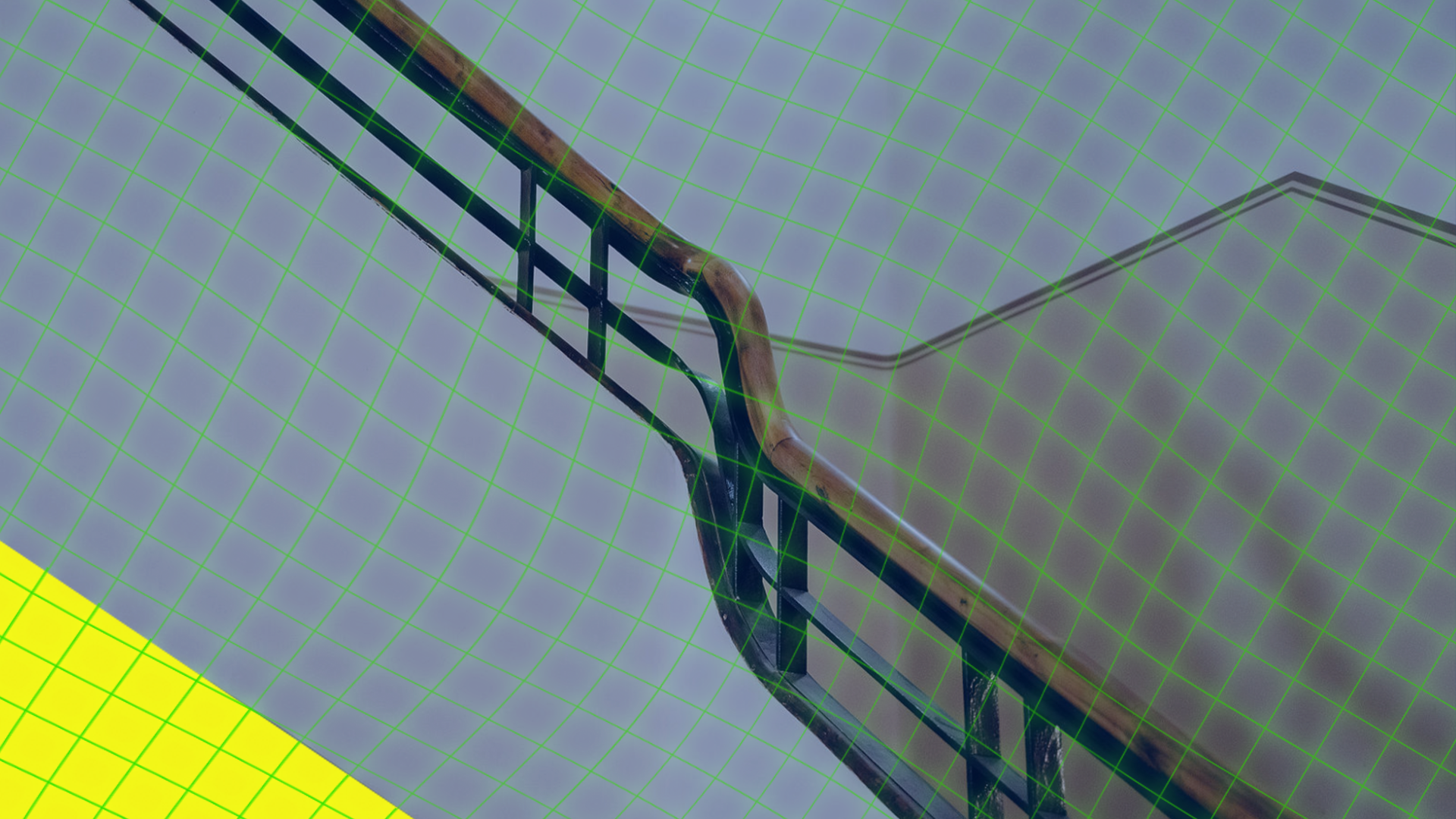
Follow www.optimismo.eu for up-to-date news, tickets and other information. The design of the website and the visual aesthetics of the festival were also inspired by the modernist heritage of Kaunas. The design department consists of Tadas Bujanauskas and Aistė Ambrazevičiūtė.
“CulturEUkraine”, a cultural-creative space for Ukrainians, opens in Kaunas: here we will find each other
2022-04-05Aktualijos,Current Issues,News,media-news
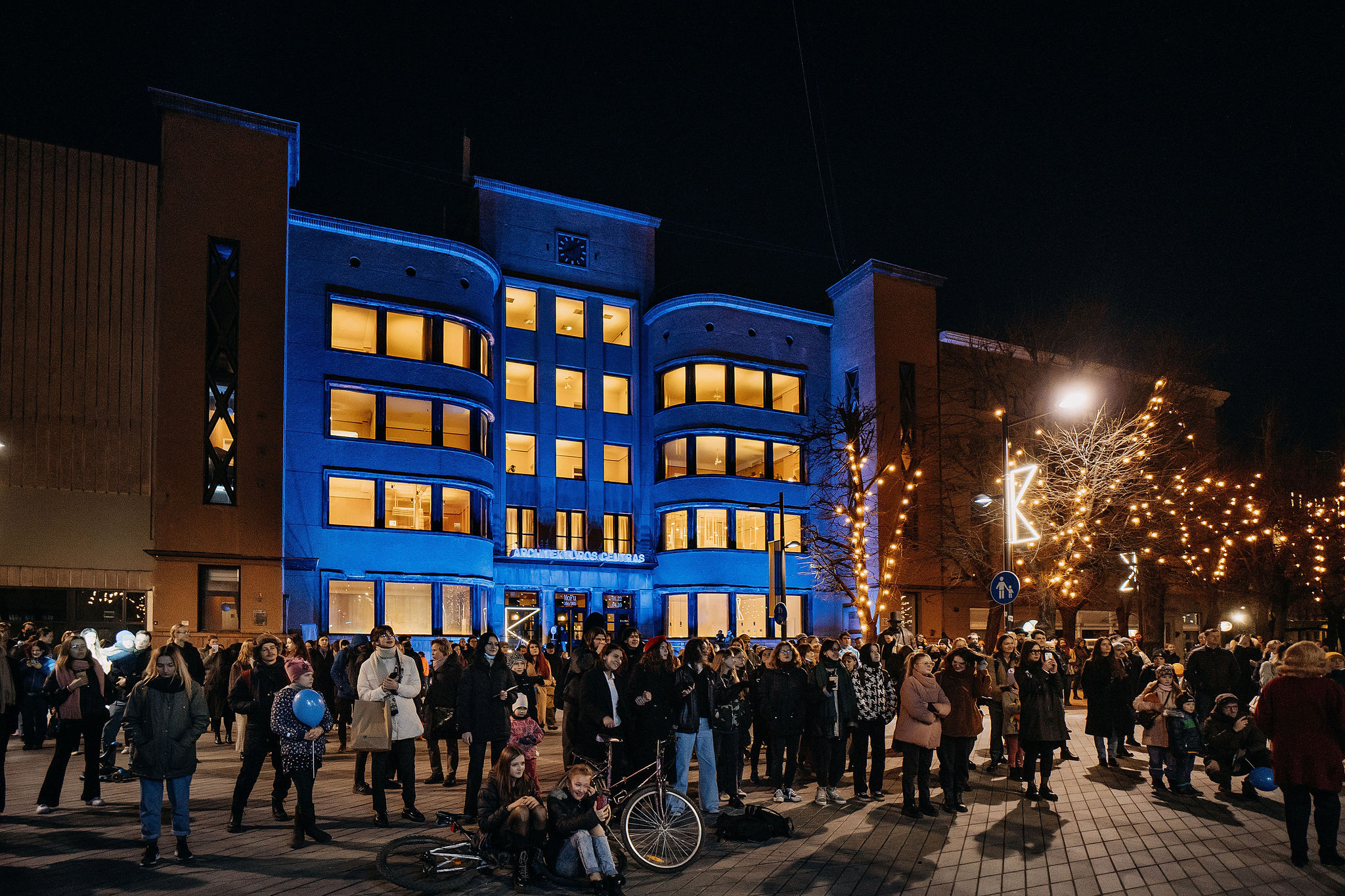
The creative-cultural space “CulturEUkraine", aimed to help Ukrainian people, who are fleeing the war and choosing Kaunas as their temporary home, was opened and presented to the public yesterday in Kaunas, in the historic Central Post Office. On the opening day, the premises of the Centre were a hive of activities: various organisations, artists, health experts and other initiatives providing and organising support for Ukraine, as well as the citizens and the first members of the emerging community – Ukrainian citizens – came to visit the Centre. In the evening, the opening of the Centre was marked by a “blue and yellow" solidarity concert featuring Lithuanian and Ukrainian performers.
As previously announced by one of the main initiators and creators of this Centre – the representatives of the European Capital of Culture “Kaunas 2022” – this Centre aims to provide a space and a place where people who have fled the war could continue their creative activities, seek inspiration and opportunities for new ones, and to simply meet, communicate, and find a bright emotional haven, which is, for the moment, of vital importance to the people that are exhausted by the horrors of war.
The Centre was visited by those who want to help and the first members of the community on the opening day
On the opening day, the 3rd floor of the Kaunas Central Post Office, which is planned to house open spaces for creativity and collaboration, art therapy sessions, communication, and educational activities, was a hive of activities: various organisations and initiatives gathered here to inform, help and support Ukraine and its people. The new Centre was also full of citizens who wanted to contribute to the creation of the Centre in various ways.
The well-known big organisations, including the Lithuanian Red Cross Society, Save the Children, and the Order of Malta Relief Service, took part in the contact fair and provided advice and information to all those who wanted to help or volunteer to join the support activities.
The representatives of the Kaunas Faculty of the Vilnius Academy of Arts were invited to join painting activities and practice art therapy. According to the organisers of this activity, it is not only a leisure activity but also an activity that enhances emotional well-being, which gives art therapy even more value and meaning.
The representatives of “CulturEUkraine” emphasized that the aim is to have a place for everyone - from the biggest to the smallest, so both when planning future activities and on the opening day, a lot of attention was paid to children – they were entertained by colourful animators, who met the small ones and their mothers at the entrance of the Centre, and invited them to engage in dynamic, educational activities.
The modernist-style premises offered many ways and forms to contribute to the financial support for Ukraine through the purchase of merchandise: “Kaunas 2022” invited to buy T-shirts supporting Ukraine that are decorated with drawings by the children of the Hero's School, and the stand of Kaunas Artists' House offered brooches with a sunflower motif carrying a symbolic meaning.
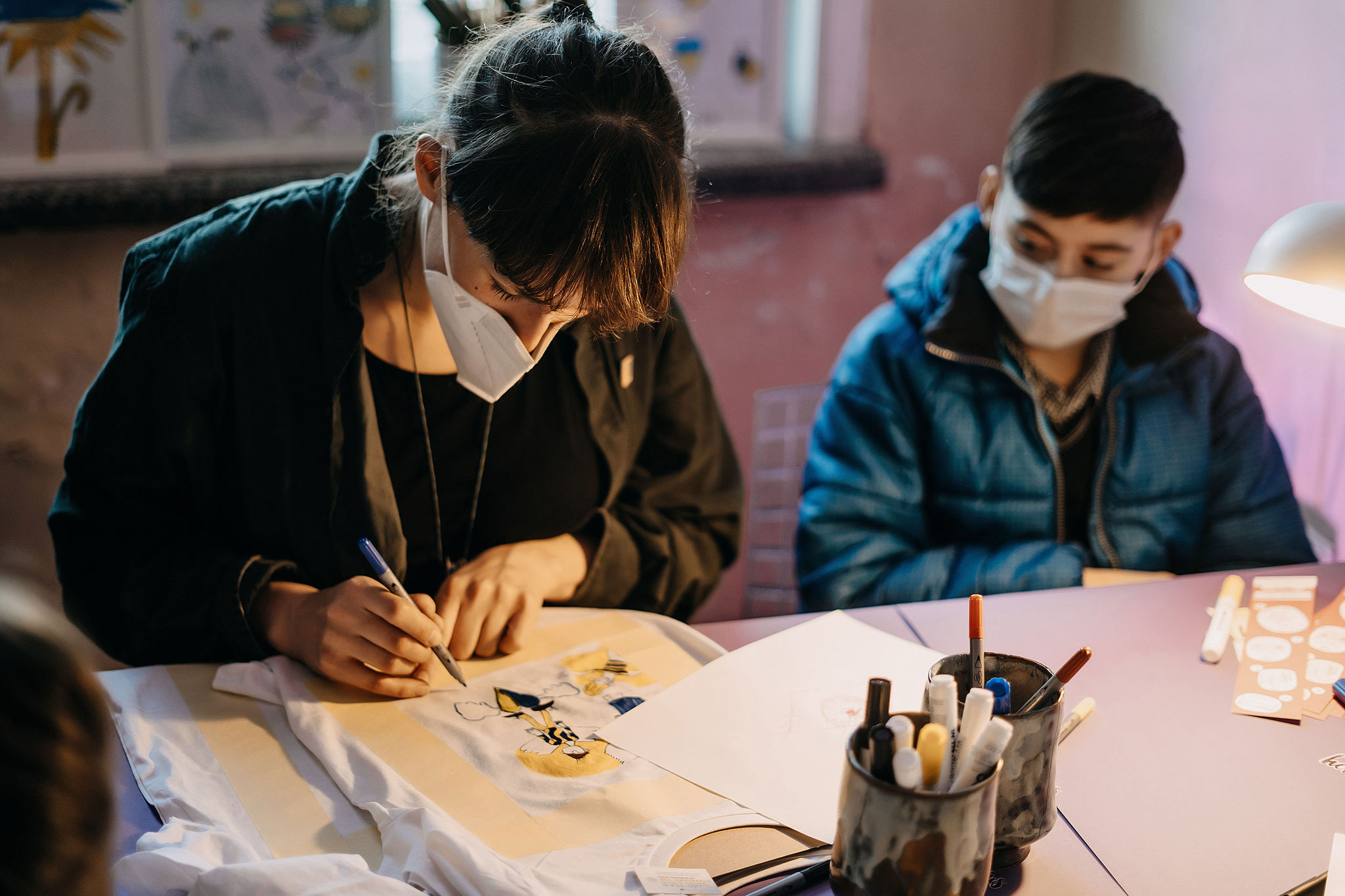
The community of Ukrainians in Kaunas: this is a space for our self-realisation and preservation of culture
The opening event was also attended by members of the Ukrainian community, who welcomed the idea of the Centre and confirmed the need for such a place. Volodimir Vasilenko, one of the representatives of the community, stated that this is a space for their self-realisation.
"For a long time, we didn't have a physical space where we could simply meet and talk, which made it difficult to build and develop the community as such. We are happy that we will have a space for self-realization, which will make it possible to learn languages and organize other cultural activities. It is a possibility for us to find each other and preserve our culture," Vasilenko spoke about the meaning of "CulturEUkraine".
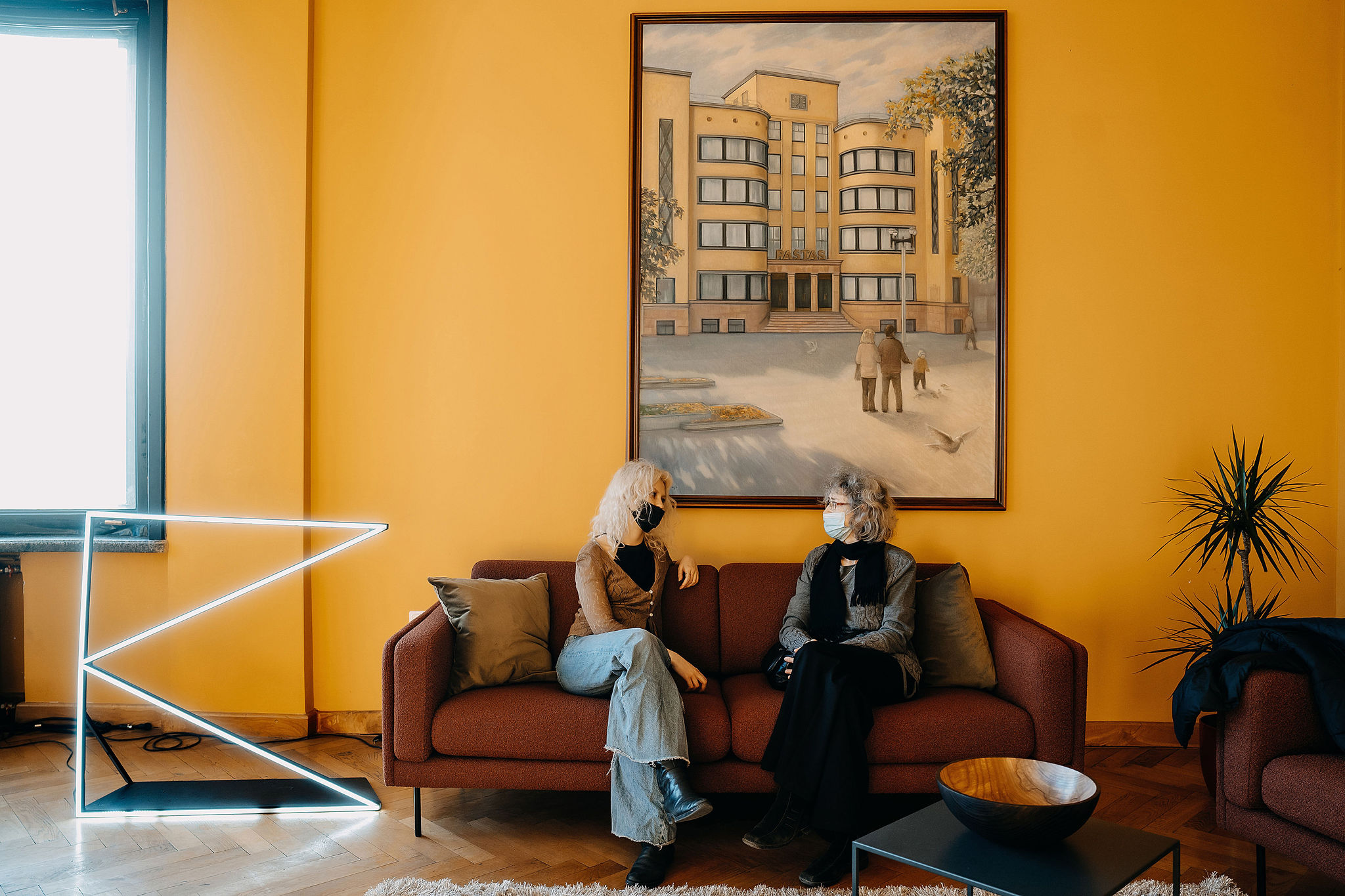
"The Blue and Yellow" concert featured exciting performances and sent a strong message: Ukraine will stand
The opening of the Centre in the spaces around the Post Office, which was decorated by blue-and-yellow lights, was marked by a gesture of solidarity: a joint concert of Lithuanian and Ukrainian artists took place on the stage on the pavement of Laisvės Boulevard.
The concert was opened with the singing of the Ukrainian national anthem by Kiril Dernovoj, an 11-year-old Ukrainian who arrived in Lithuania several weeks ago. Kiril, who showed his powerful voice and firm posture on stage, touched many people’s hearts – the audience greeted the little Ukrainian with applause and shouted “Slava Ukraini".
Another performance by Ukrainians – a trio of musicians coming from various parts of Ukraine, who had just met a few hours earlier and who didn’t know each other until the morning of the performance day – was also very exciting. A flawless instrumental performance of classical works by the trio of Kondratyeva Olga Mikhailovna (violin), Nekh Nikita Alexandrovich (violin), Radkova Natalia Stanislavovna (violin) delighted the audience.
The 3rd Secretary of the Ukrainian Embassy to the Republic of Lithuania, Elena Kuzmenchuk, in her short but strong speech on the stage thanked Lithuania for its support and conveyed a clear message that Ukraine and its people, showing their strength, will withstand any difficulties.
The concert also featured Lithuanian artists: songs by Šarukas Joneikis (member of the band “Garbanotas”), Clara Giambino, electronic music performer Mesijus and mathematical rock band “jautì” were performed.
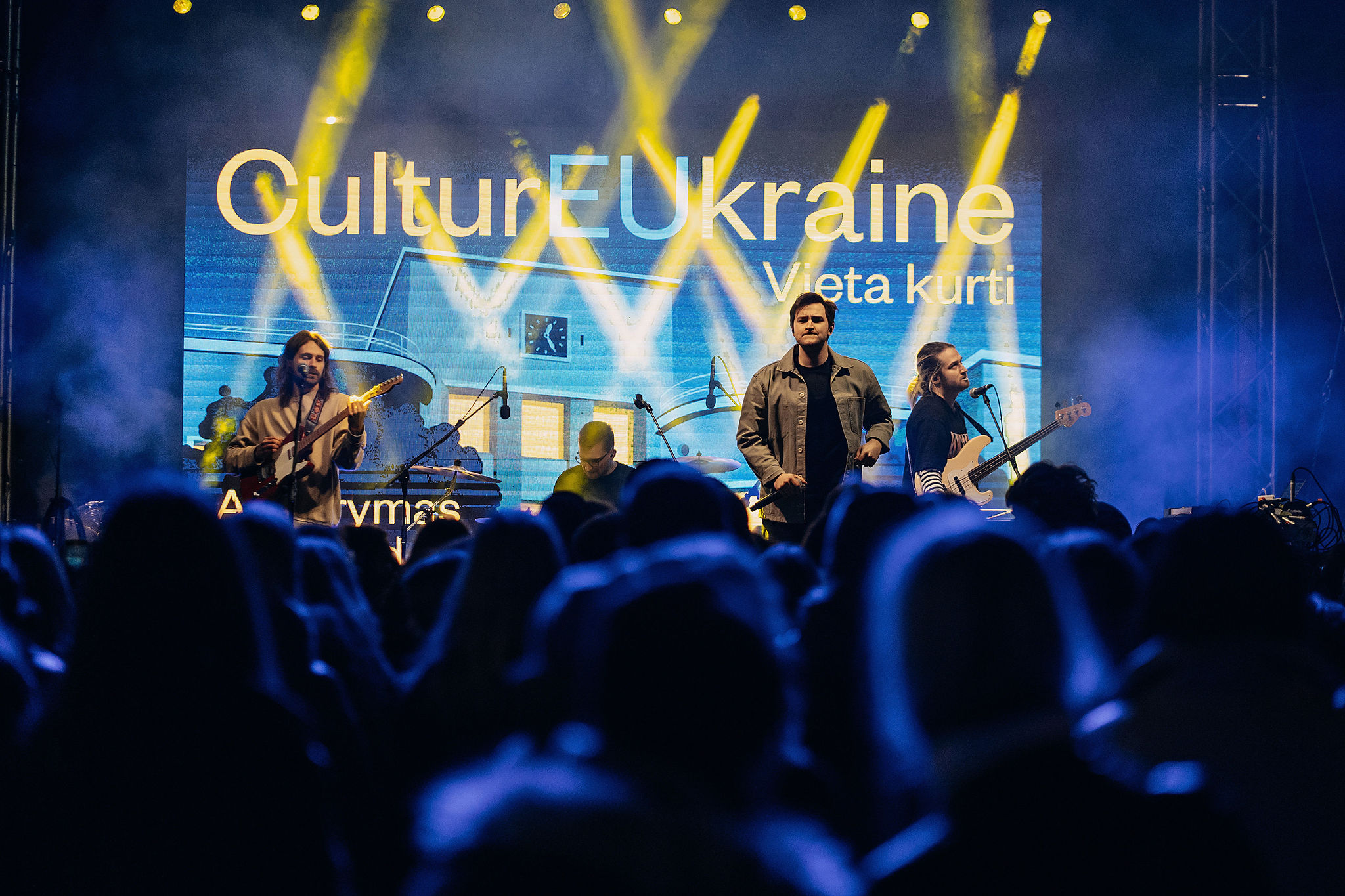
The opening of the Centre is just the first step toward further activities
During the closing ceremony, Virginija Vitkienė, Head of “Kaunas 2022”, emphasised that the opening of the Centre is only the first firm step towards big, sometimes full of challenges, works. Activities for Ukrainians will start here next week and registration is open now in this form.
The curators of the “CulturEUkraine” space remind that citizens are still actively invited to contribute to the creation of the Centre by donating essential household items, especially IT devices - computers, monitors, tablets, etc. We invite you to register any items you have that you would like to donate to the Centre here.
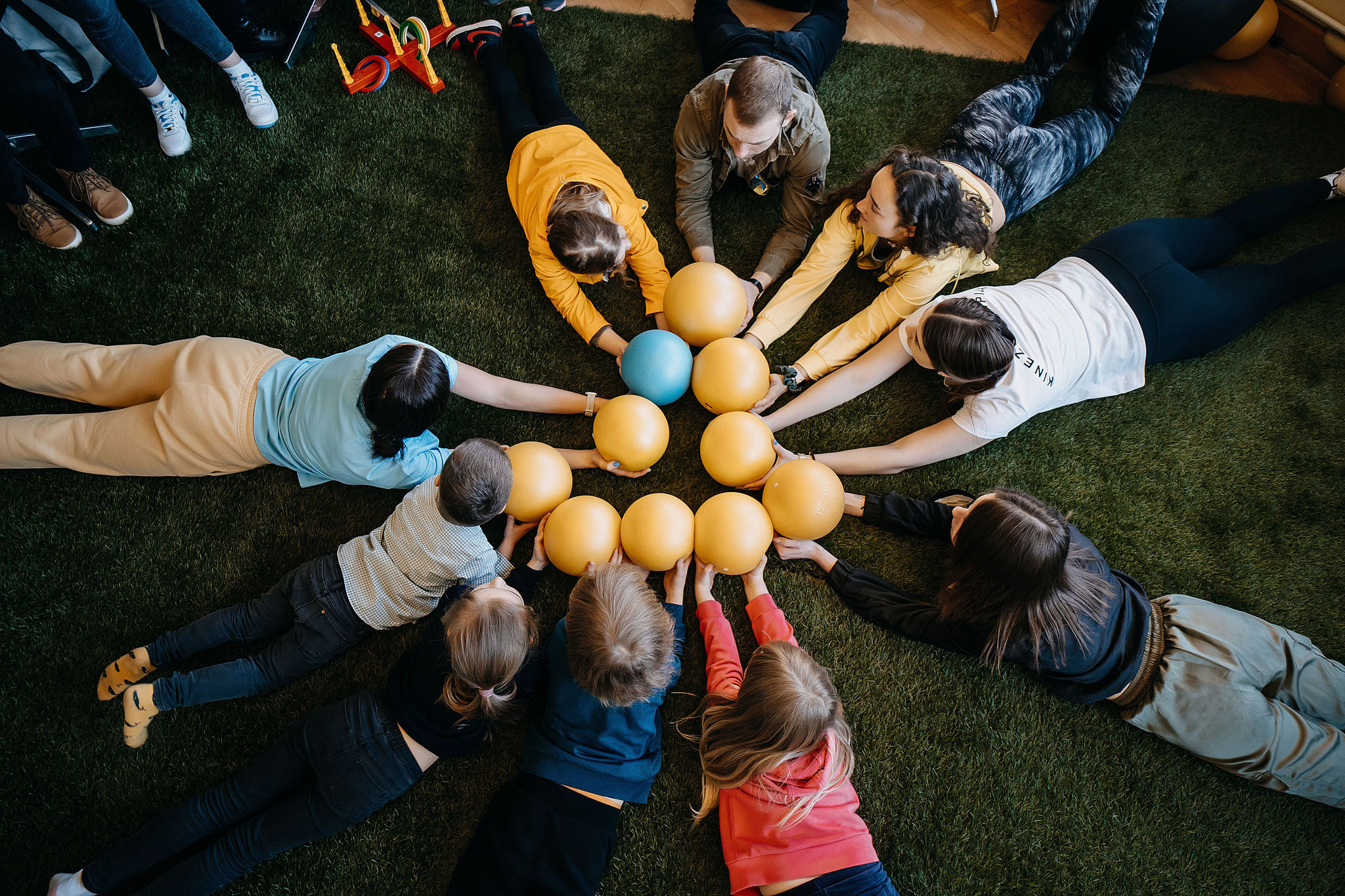
The report was prepared by Vaida Morkūnaitė
Photo author Martynas Plepys
Marina Abramović in Kaunas. Deciphering Contemporary Art and Sending Energy to Ukraine
2022-04-01Aktualijos,News,Aktualijos
Six thousand people, holding each other’s shoulders and sending the energy of love to Ukraine, currently fighting for its freedom. It was not a protest or a rally in the central city square. It was six thousand people gathered in Kaunas on the evening of 31 March to hear Marina Abramović talk about performance art and life in art. The most recognisable art world figure to visit Kaunas started the evening with the following words: “I have an additional part of the lecture because of the current war situation.”
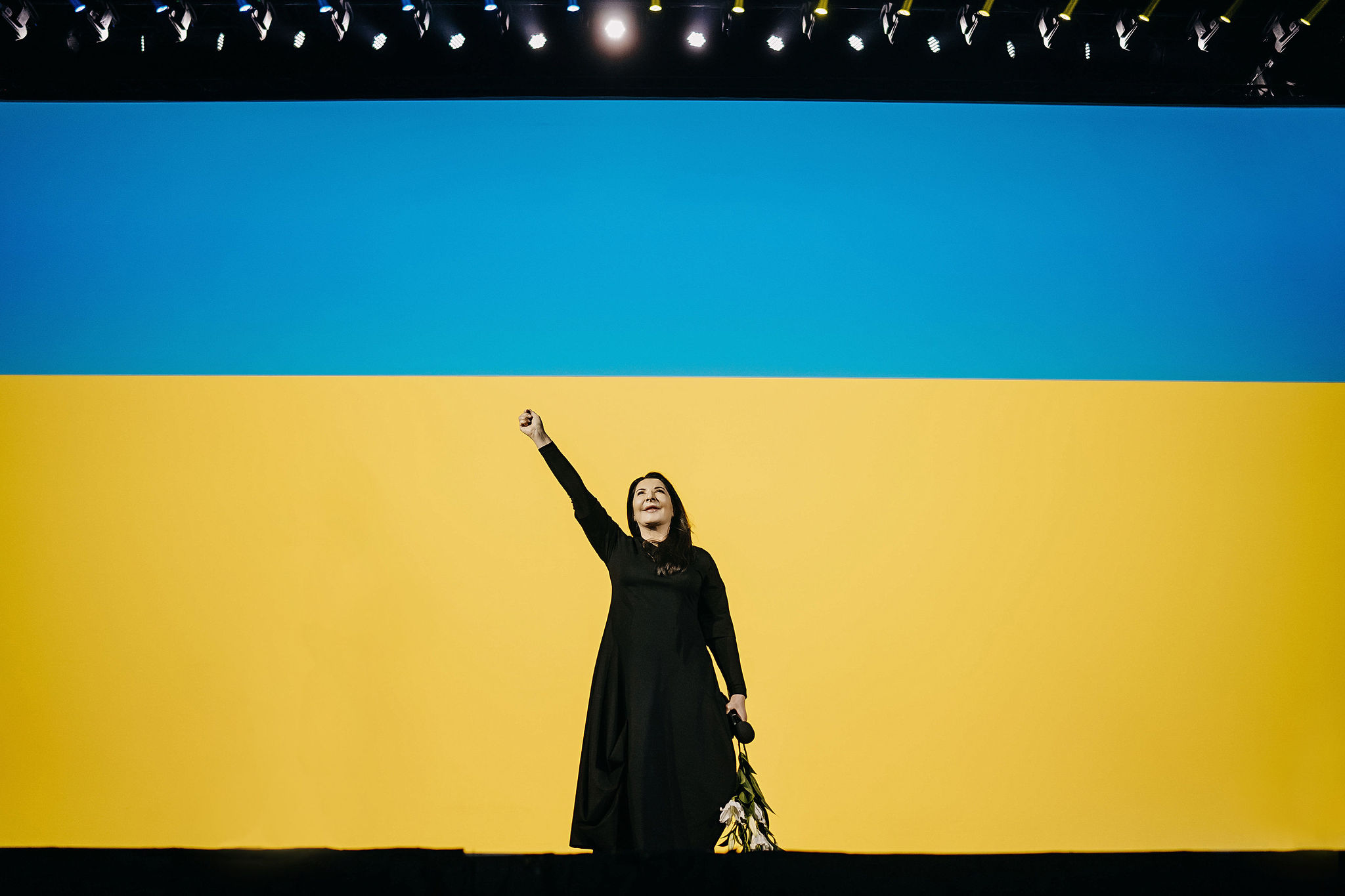
The artist came to the homeland of her friend Jonas Mekas to launch her retrospective exhibition “Memory of Being”. The opening event was accompanied by a lecture “The Past, Present, Future of Performance” at the Žalgirio Arena, which was crowned by an artistic message supporting Ukraine and a short yet impressive Q&A session. This was one of the events of the Kaunas - European Capital of Culture 2022 programme that attracted the most extensive local and international interest.
“This is the biggest audience I have ever had,” smiled the Serbian-born artist as she greeted the people from all over Lithuania and abroad. Abramović, who almost five decades ago switched Yugoslavia for the liberal West, where she blossomed as an artist, gave, in a good two hours, a comprehensive introduction to performance art and its influence on other, often more traditional, fields of art.
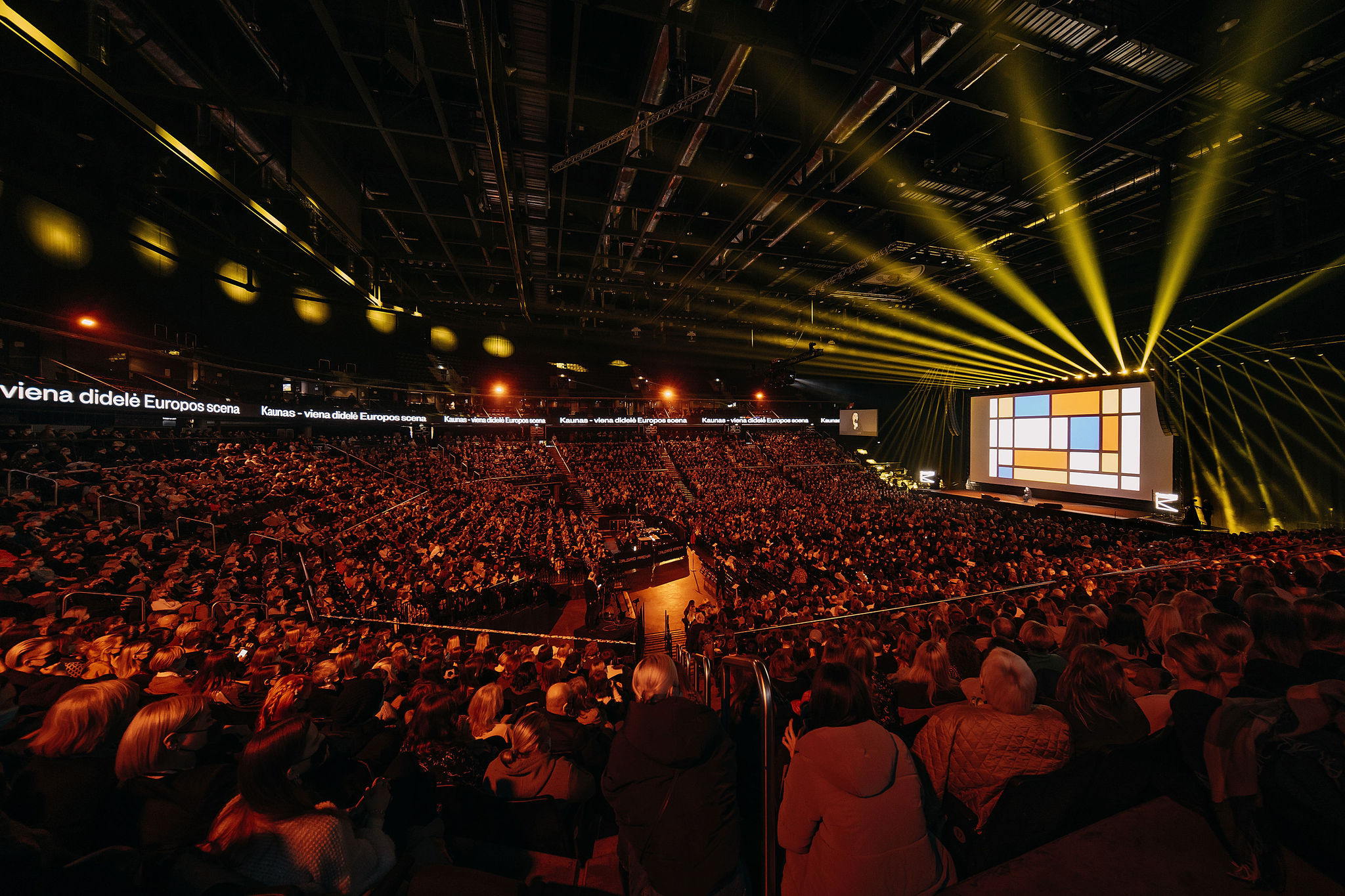
References to essential names and their works - performance videos, music pieces, film extracts - were supplemented by insights into the artist’s place in humanity, the Abramović method she has refined to achieve the best possible results, the relationship with the other, and the cost of being an artist, which includes sacrifice, suffering and loneliness.
The fragmentary yet broad perspective of Abramović’s own work became for some a timely repetition of what they have read, heard and seen, as well as a way to make connections before visiting the exhibition at the Kaunas Picture Gallery, while for others, it turned out to be a key to further acquaintance with contemporary art and its seemingly unlimited forms and the possibilities of human mind and body.
“ex-Yugoslavia was a bridge between the East and the West, the Eastern and Western concepts of time - and on a bridge, there is always wind,” the artist began to explain the difference between Eastern and Western concepts of the body. She mentioned that people rely on technology in the West, while in the East, they trust intuition and the power of the body itself. “I have been to the East many times, I have participated in many rituals - not as an observer, but actually to understand how I can best use my body in the best possible way, to push my mental and physical limits - and by learning this, I could take Eastern practices to the West and create art.”
Interestingly, religion and a lack of belief in anything other than oneself are intertwined in the artist’s life. As a child, she was under the care of a very religious grandmother and was later brought up in a more liberal environment; she believes this contrast helped her to learn and maintain the discipline that is necessary for an artist’s practice. “I don’t think everyone can be an artist, and I don’t think artists can change the world - but they can point to important questions; they are servants of society and have to be responsible,” emphasised the guest who visited Lithuania at the invitation of Kaunas 2022 and the Meno Parkas Gallery.
Abramović made several references to Ulay, the recently deceased German performance artist Uwe Laysiepen, with whom she lived and worked for twelve years, exploring, to put it very briefly, the relationship between the couple and their bodies. A large screen in the Žalgirio Arena also showed recordings of several of their performances. “We parted on the Great Wall of China - each of us walked 2,500 km to do it. Why couldn’t we do it over a phone call? Well, we wanted to have a dramatic ending,” Abramović joked delicately. Both she and Ulay were born under the sign of Sagittarius and met on their shared birthday, a coincidence that was symbolised by the performance Rest Energy in Amsterdam in 1980. “It was only four minutes long, it was the shortest, and I thought it was the longest,” recalled the artist. Rest Energy is a piece about absolute trust when your life depends on others. The impression was reinforced by microphones attached to the artists’ chests so that they could hear their hearts beating faster and faster.
Among the names such as Bruce Nauman, Laurie Anderson, Pina Bausch, Alejandro Jodorowsky, Abramović mentioned the Taiwanese-American artist Tehching Hsieh. “I am not inspired by others. Why should I be inspired ‘second-hand’? I go to the source - nature inspires me. But there is one person I call a master. It is Tehching Hsieh. This man only made five pieces in his life. Every piece lasted one year. Then I asked him - what are you doing now? He said - I’m doing life; I am living my life. I realised that he had gone through a transformation - he had reached the highest stage possible for a human being,” the artist told the audience in Kaunas. She says that true Zen is only achieved by doing difficult things because it is very easy to do what you like. Don’t be afraid to explore, don’t be afraid to make mistakes - such seemingly simple advice should not be overlooked if you want to do more than 100%. And, according to Abramović, you need to do 150%.
Although her work explores essential, complex and often difficult themes, a cool head and a healthy sense of humour are integral. “I am going to sit and talk to you; after all, I am 76,” the artist laughed after standing at the beginning of her lecture. She also mentioned the talent to joke when talking about Jonas Mekas, whom she described as a great human being. “I divide the world into two sections - the originals and those who follow. John Mekas was a true original,” Abramović said what the audience received with an ovation.
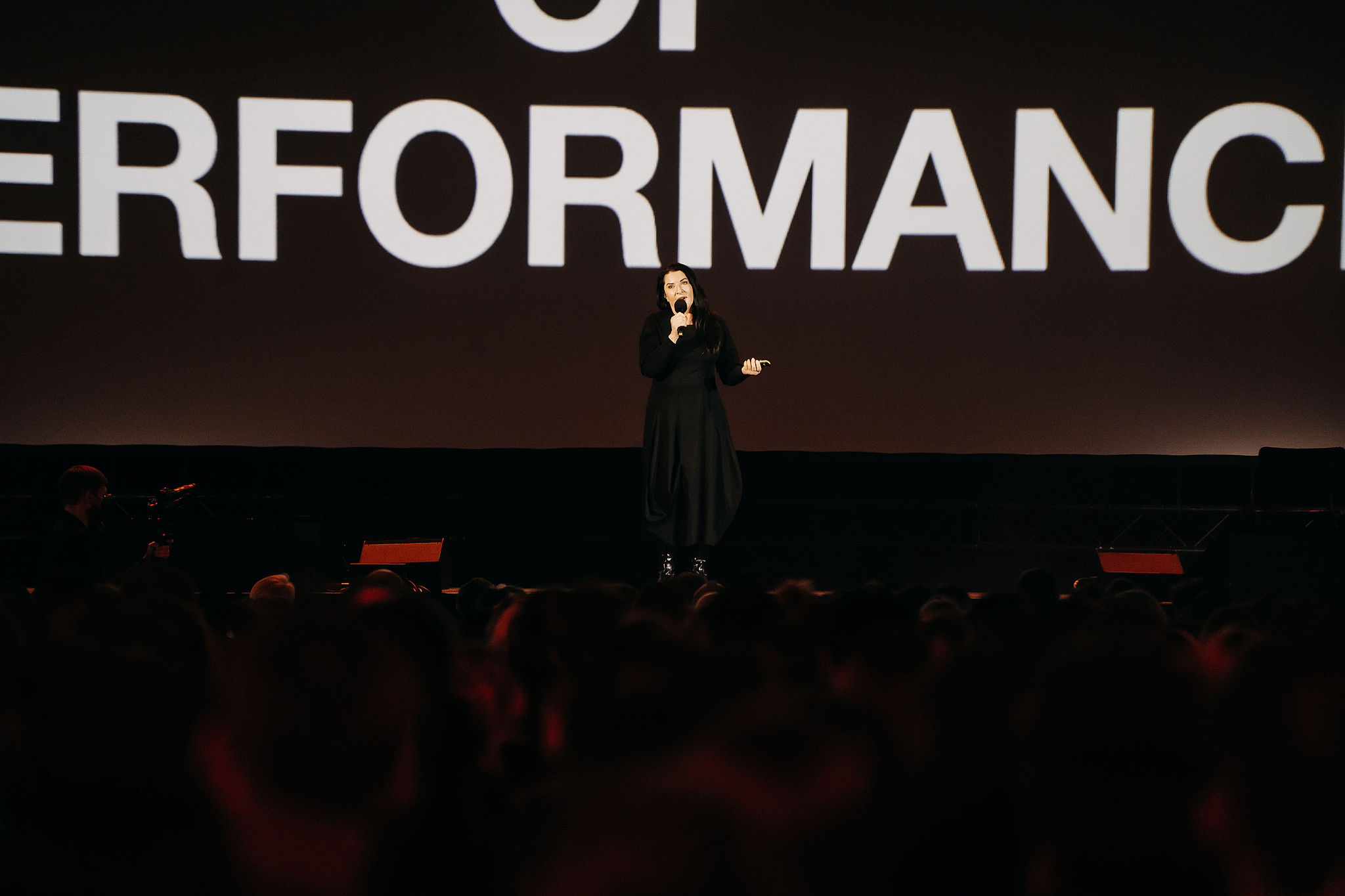
There were dozens, if not hundreds, of those willing to meet the icon in person. Still, only those who attended the opening of the “Memory of Being” exhibition on Tuesday could get the celebrity’s autographs or take a selfie. However, after the lecture on Thursday evening, a few of the attendees were invited to ask questions. An artist from Ukraine, currently in Kaunas, asked how to start making art after experiencing great pain. Abramović revealed that after the Balkan war, she felt great shame and was highly shocked - she was unable to create for two years; it was just too difficult. In order not to become a daily newspaper with yesterday’s news, it takes time to digest information and to create a work of art that speaks not only about a specific war, the war in Ukraine, but about war in general.” Here, Abramović mentioned her bloody performance Balkan Baroque, which was awarded the Golden Lion at the Venice Biennale in 1997.
On the occasion of Kaunas - European Capital of Culture 2022, Meno Parkas Gallery presents the exhibition “Memory of Being” by the art world icon and performance artist Marina Abramović, which is on show at the Kaunas Picture Gallery of the National M. K. Čiurlionis Museum of Art (K. Donelaičio st. 16, Kaunas) from 30 March to 31 July. The exhibition, which consists of video and sound installations, offers an opportunity to get acquainted with the artist’s creative biography, her famous Manifesto and her unique creative method, as well as to see interviews with the artist and other documentary material and to purchase the catalogue “The Cleaner”, the most comprehensive catalogue of Abramović’s work to date, which has been published especially for the occasion in Lithuanian.
Photos by Martynas Plepys
A space to create: Kaunas to open a cultural centre empowering Ukrainians to create
2022-03-17Current Issues,News,media-news
As Lithuania is hosting increasingly more people of Ukraine fleeing the atrocities of war, public organizations and individuals are actively contributing to various forms of initiatives for support. One of them is the cultural field, therefore, on Thursday, March 17, “Kaunas 2022”, along with its partners, is inviting visitors to Kaunas Central Post Office where a cultural-creative space “CulturEUkraine”, dedicated to the creators and artists of Ukraine who have chosen Kaunas as their temporary home, will be opened. It is planned that organizations, communities, and other initiatives contributing to the support for the people of Ukraine will gather here.
Cultural support: a possibility to continue the work, a place to create and be visible in Europe
“Currently, all active civil initiatives, NGOs, and public institutions are joining forces and contributing to the safe arrival of Ukrainians, helping them find accommodation and providing them with the necessities. It is like a synergistic mechanism, in which the mission of Kaunas 2022 is to offer a cultural harbor, creative space, and visibility platform for creators from Ukraine,” Head of “Kaunas 2022” Virginija Vitkienė spoke of “CulturEUkraine” idea.
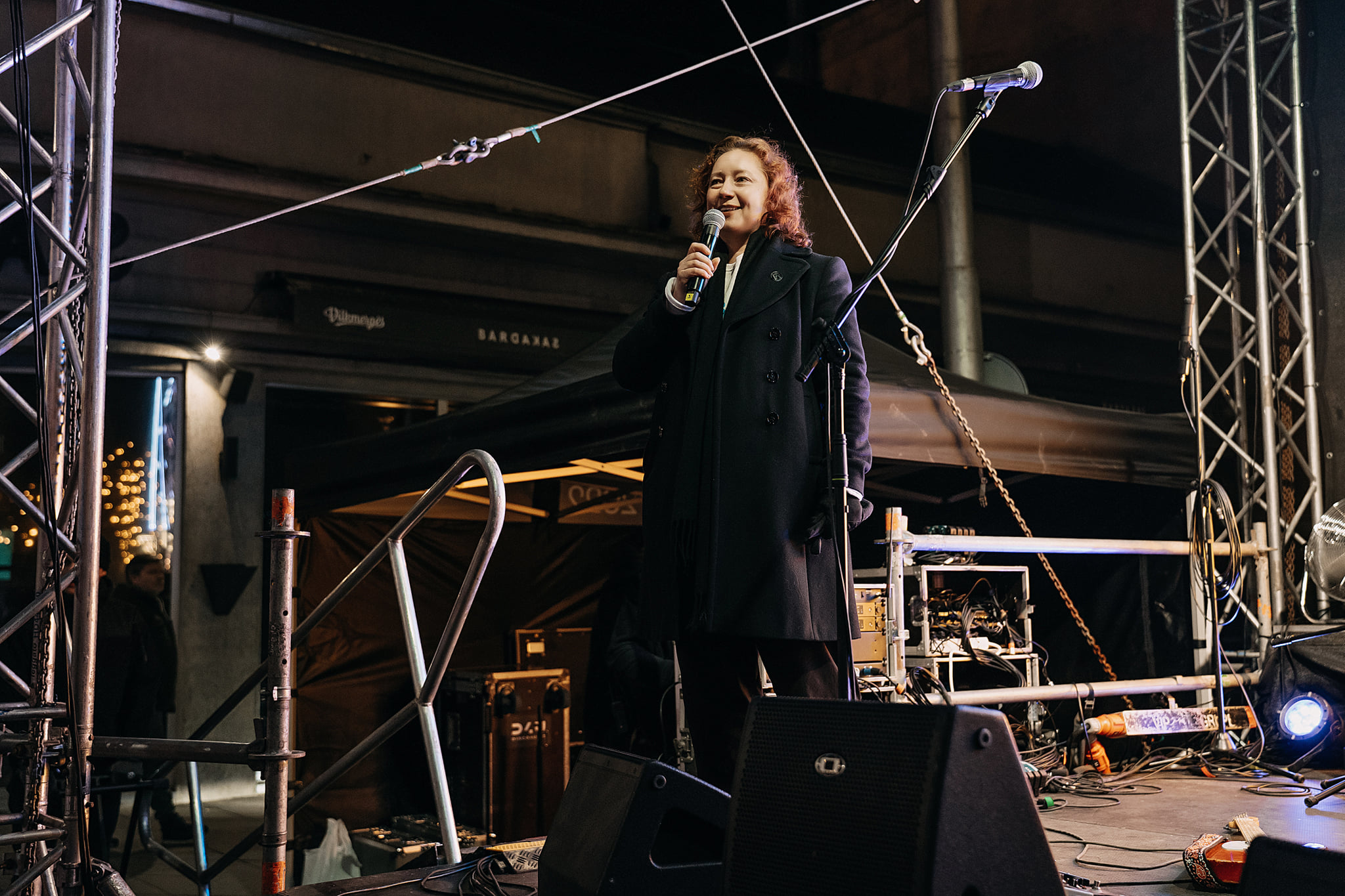
On 17 March the centre “CulturEUkraine” will be opened on the 3rd and 4th floor of Kaunas Central Post Office. It is planned that open spaces will be established here for creation and co-working, there will be zones for art therapy, communication, and spaces for exhibitions.
“We are striving to make this Centre a place where the voices of people of Ukraine and the news of Ukraine are heard across Europe. We hope that the creators who arrive here will be able to continue with their activities by maintaining relations both with the local artists and those who stayed in Ukraine. By providing support, it is important to ensure that their adaptation in our country is as smooth and emotionally easy as possible; therefore, we will create a possibility for them to continue their usual activities and to contribute with their creative solutions to make the war come to an end and to achieve Ukraine’s victory as soon as possible. The Centre “CulturEUkraine” will become a place to meet, communicate, create, relax or contact their relatives. We hope that various cultural partners, artists will settle down in the spaces of the Post Office. We will also contribute to the support in preparing exhibitions, meetings. Culture and creation help to overcome difficulties hence we expect that the project will contribute to the improvement of emotional wellbeing,” V. Vitkienė spoke.
Community support is essential for the establishment of the Cultural Centre
The organizers are inviting everybody to contribute to the creation of a cosier, more functional space.
“In the processes of creation and development of the “CulturEUkraine” space, the contribution of the business sector is especially important. Therefore we are inviting the representatives of both large and small businesses to help to make the cultural spaces cosier and lay the foundation for the birth of a new community. Of course, the support and involvement in the process of creation of this space of citizens of Kaunas are also very important. Without the energy brought together by the people, without their help, support, and ideas it would be impossible to reach these noble aims, so, the involvement of each person is very important,” one of the organizers of the initiative, “Kaunas 2022” sponsorship manager Irutė Tumaitė said.
The representatives of this creative space emphasize that, currently, the most needed are the items that would help to equip a quality place for creation; and later on, once the project gains momentum, the contribution and support of the society and business could be expressed in other forms, i.e. by organizing activations, educational, well-being activities for the community.
“The most necessary items now are various household appliances – from lamps, lights, heaters, mirrors, furniture for sitting and writing, inventory for children (toys, puzzles) to those used for household chores – brooms, vacuum-cleaners, kitchenware, cutlery, and small appliances,” I. Tumaitė said.
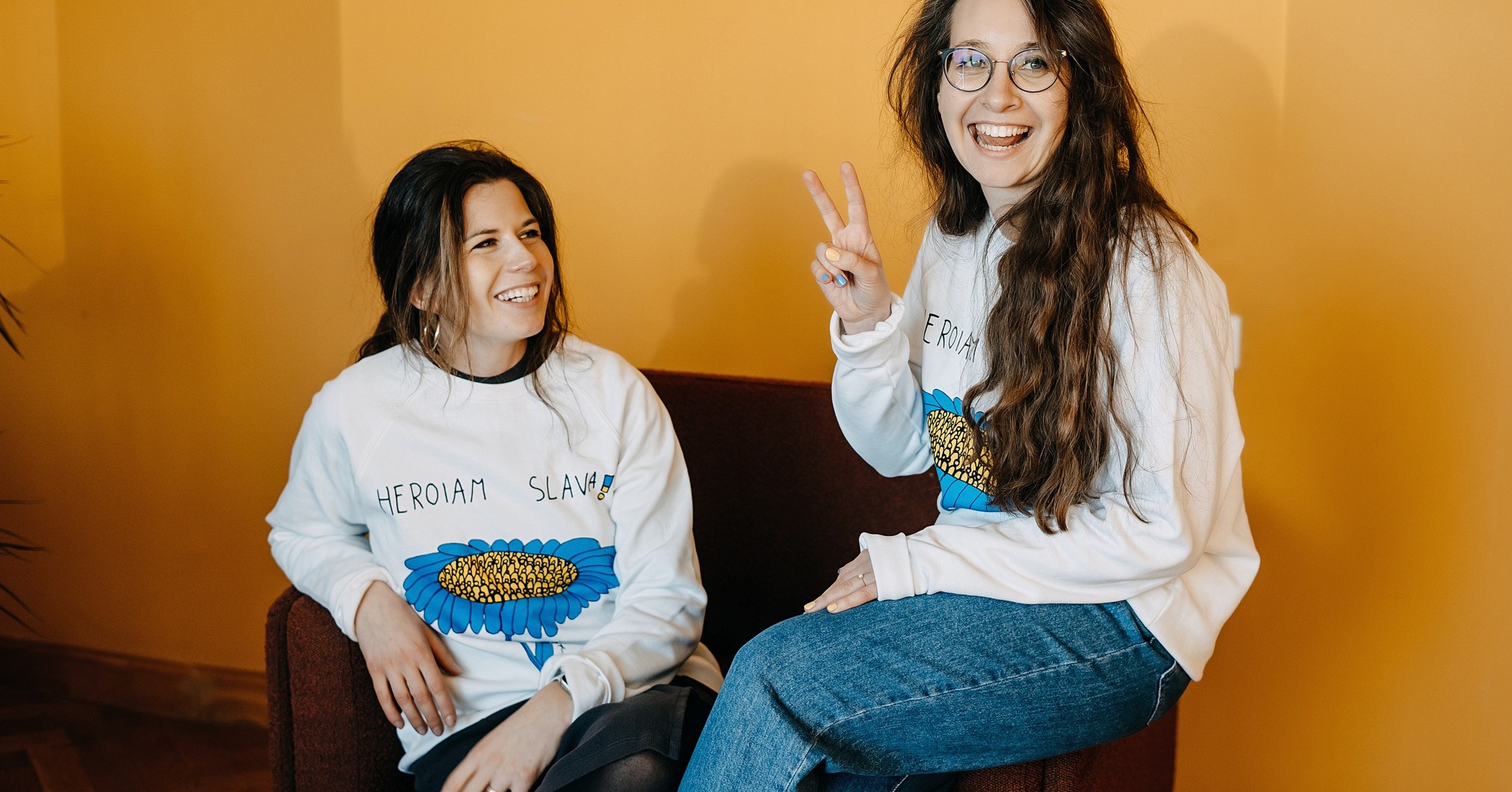
The citizens of Kaunas are invited to bring the items to the premises of Kaunas Central Post Office from 11 March. The items will be accepted at Kaunas Central Post office (located at Laisvės al. 102, Kaunas) daily until 17 March, from 10 a.m. to 6 p.m. If you have large items, please contact us and we will collect them from your provided location (email for information [email protected])
An opening ceremony of the Cultural Centre for Ukraine, gathering of the support initiatives and hospitality concert to take place on March 17
On March 17 the creative space “CulturEUkraine” will be officially opened. Organizations and initiatives providing and organizing support for Ukraine will be established on the 3rd floor. Communication, getting information and contact will be possible from 4 to 8 p.m.
The aim of this gathering is to present all the relevant information about the activities that are organized to host the Ukrainians temporarily staying in Kaunas. It is also important to show that we stand together. Visitors will be able to purchase souvenirs, symbols, pieces of art here; a space of “Kaunas 2022” will be open here too.

Both inside the post office and around it, hospitality to Ukrainians will be shown: in the evening, the historical building will be lit by a symbolic combination of blue and yellow, and nearby – at the intersection of Laisvės Alėja and Kanto Street a live concert will be held to support Ukraine and its people.
Photo author Martynas Plepys
Open call to join Courtyard Festival
2022-03-17Open Calls,Archive open calls,Open Calls
“Kaunas – European Capital of Culture 2022” is inviting artists and community representatives to co-create the Courtyard festival.
The festival is a tradition to foster community-building and friendship among people living in Kaunas city and district. On the festival day, various communities, organizations, and neighbors bring their chairs and tables to the city center and decorate it with white tablecloths and flowers. Food culture plays a central role in the festival: every year communities bring their favorite dishes and share the meals and stories with each other.
Besides the city-wide dinner, the festival is also marked by music, creative installations and different kinds of performances in unexpected public places, often created by the participants themselves. See the mood and many layers of the event in the videos of the year 2019 & 2021.
The Courtyard festival celebrates the friendship and unity of the city’s residents, guests and neighbors – there is no coincidence that the event is organized on the International Neighbors’ Day. Other important topics in the festival this year will be the relationship between man and river, ecology and other green course ideas.
Sounds tempting? Be our guest!
We invite You to celebrate communities together on the 20th of May, 2022. If you have projects, performance, visual arts or other ideas related to the topics listed above – you are more than welcome to share them in Kaunas! Participating communities are also encouraged to bring their national dishes to the tables of the Courtyard Festival.
Bring up to 15 members of Your community together and join the feast by enriching it with Your food, talents, and stories.
We will be happy to offer you Kaunas as a stage, discuss how we can implement Your ideas and cover accommodation and catering during the day of the event.
Application form: https://forms.gle/tx45Cpaq18wfaPay7
Any questions? Contact us!
Email: [email protected] Phone: +370 622 78274
Kaunas – the grand cultural stage of Europe: what not to miss in March
2022-03-04Current Issues,News,media-news
Kaunas has become a huge European cultural stage; this year there will be more events taking place than there are days in a year. The boundless and borderless “Kaunas – European Capital of Culture 2022” programme is flooding both the usual and the most unexpected spaces of Kaunas, and Kaunas district – the culture here is inescapable!
Here is a list of highlight events that will take place in Kaunas in March to plan your cultural experiences more easily. The organizers of Kaunas 2022 remind that you can easily find the detailed programme for the whole year on the website www.kaunas2022.eu or always have it at your fingertips in the mobile app KAUNAS 2022.
Events not to miss in March:
The International Day of Happiness, 20th of March
The last challenging years highlighted the importance of the people connection – our families, colleagues, neighbours, and other community members. Therefore, the organizers chose the slogan “Happiness to celebrate together” for the Day of Happiness in 2022 to announce that the biggest happiness is celebrating together – with people and among the people! This year the Day of Happiness invites us to share the moments of joy longer – the celebration, which starts on 20 of March, will continue during the whole weekend! Furthermore, an international congress “On happiness. Presuppositions 2022. Communities” will be held for the very first time.
Where: Different places in Kaunas
When: 20th of March
The event is free. The event is accessible to people with physical and intellectual disabilities and suitable for families with children. Pets are allowed at the event. More information: www.laimesdiena.lt/en
"Memory of Being", an exhibition by Marina Abramović
One of the most significant art events not only in Kaunas but also in the whole Lithuania, will be Memory of Being, a solo exhibition by Marina Abramović, one of the world’s most renowned artists, in Kaunas Picture Gallery. The exhibition provides a detailed presentation of the most important stages of Marina’s work since the 1960s. It will feature video documentations of her interviews and most famous works, as well as the artist’s best-known video installations. One of the exciting news for art lovers is also that the creator herself is coming to Lithuania to share her thoughts and ideas during a public meeting in Žalgiris Arena.
Where: Kaunas Picture Gallery, (K. Donelaičio str. 16, Kaunas)
When: 30th of March – 31st of July
Paid event
“That Which We Do Not Remember”, an exhibition by William Kentridge
One of the world’s most influential contemporary artists, an honest and painfully candid humanist whose exhibitions are coveted by the best galleries in the world, is bringing his art to Eastern Europe for the first time to open the most significant show of the Kaunas 2022 programme. The exhibition at the National M. K. Čiurlionis Museum of Art, That Which We Do Not Remember, will compel you to forget stereotypes. In this exhibition, Kentridge addresses humanity’s selective memory. The rejection of facts, history, and memories as a means of self-preservation or a propaganda tool is just as common a characteristic among people in Johannesburg and Rome as it is in Kaunas, says Kentridge, and calls us to dialogue with ourselves.
Where: M. K. Čiurlionis National Museum of Art (V. Putvinskio str. 55)
When: Until 30th of November
The event is accessible to people with physical disabilities. Paid event. You can get the tickets here
„Modernism for the Future 360/365“, an international exhibition
Launched on the opening weekend of Kaunas 2022, this exhibition is an extraordinary report about the Modernism for the Future Programme. Over twenty artists from five countries spread their relationship with architectural heritage and its fate in contemporary European cities, such as Kaunas, at the iconic Kaunas Central Post Office. The exhibition encourages current residents and owners of modernist buildings to treasure their property and motivate the city to take pride in this legacy and present it to visitors and tourists. With this exhibition, Kaunas takes the lead in the modernism preservation movement and finally establishes itself as a centre of world research, promotion, and attraction of modernism in the world. The significance of Kaunas as a centre of global modernism will be one of the most important and enduring achievements long after the European Capital of Culture project comes to a close.
Where: iconic Kaunas Central Post Office (Laisvės alėja 102)
When: Until 10th of April
The event is accessible to people with physical disabilities. Paid event. You can get the tickets here
“Stories of the House”, an exhibition
The historical palace commonly known as the residence of the Presidents of Lithuania (1919–1940) has reshaped itself. Time portals will take you to seven epochs: the Governor’s Palace, the Ober Ost Commander’s residence, the Presidential Palace, the house of the Supreme Council Presidium, Nazi Headquarters, the Teachers’ House, and the revived historical palace. The motley list of its residents and visitors includes Tsars, Kaisers, military commanders, artists, and even a Pope! The palace is as if a crossroads of the history of Kaunas and entire Europe. The new exhibition will surprise city residents and its guests: here, history can be seen, heard, touched, smelled…
Where: Historical Presidential Palace of the Republic of Lithuania in Kaunas (Vilniaus str. 33)
When: Until 15th of July
Paid event
Kino Pavasaris Pop-up Cinema: „Pilgrims“ are coming back home
With the International Vilnius Film Festival “Kino Pavasaris” approaching (start on the 24th of March), exclusive screenings of “Pilgrims” (directed by Laurynas Bareiša) – a crime drama that won the Venice film festival lion – will be waiting for Lithuanian cinema lovers. For the film’s Lithuanian premiere, “Kino Pavasaris” will build a pop-up cinema in Karmėlava, the town in Kaunas District featured in “Pilgrims”. The team will also present an immersive guide of filming locations around town.
Where: Karmėlava, Kaunas district
When: from 17th of March
Paid event
“ARNO FUNKtionalism”, an exhibition
This exhibition is dedicated to one of the city’s most renowned interwar architects, engineers, and masters of interior design, Arnas Funkas (1898–1957). Funkas introduced the principles of functionalism to residential and public architecture and designed numerous representative examples of the style in Lithuania. This show will present Funkas’ work and explore the principles of interior and building architecture prevalent in his time and which became a unique feature of Kaunas, representing the city’s architectural landscape.
Where: A. and P. Galaunė house-museum (Vydūno al. 2)
When: Until the 1st of July
Paid event
Don’t Miss the Chance to meet Marina Abramović in Kaunas, the European Capital of Culture
For one night only, only with those who have secured their tickets in advance. The Serbian artist Marina Abramović, synonymous with performance art, has promised to meet her fans in Kaunas, the European Capital of Culture. She is scheduled to give an open lecture on 31 March 2022.
The artist will travel to Lithuania to open her exhibition “Memory of Being”. The show will be available to the public at the Kaunas Picture Gallery from 30 March.
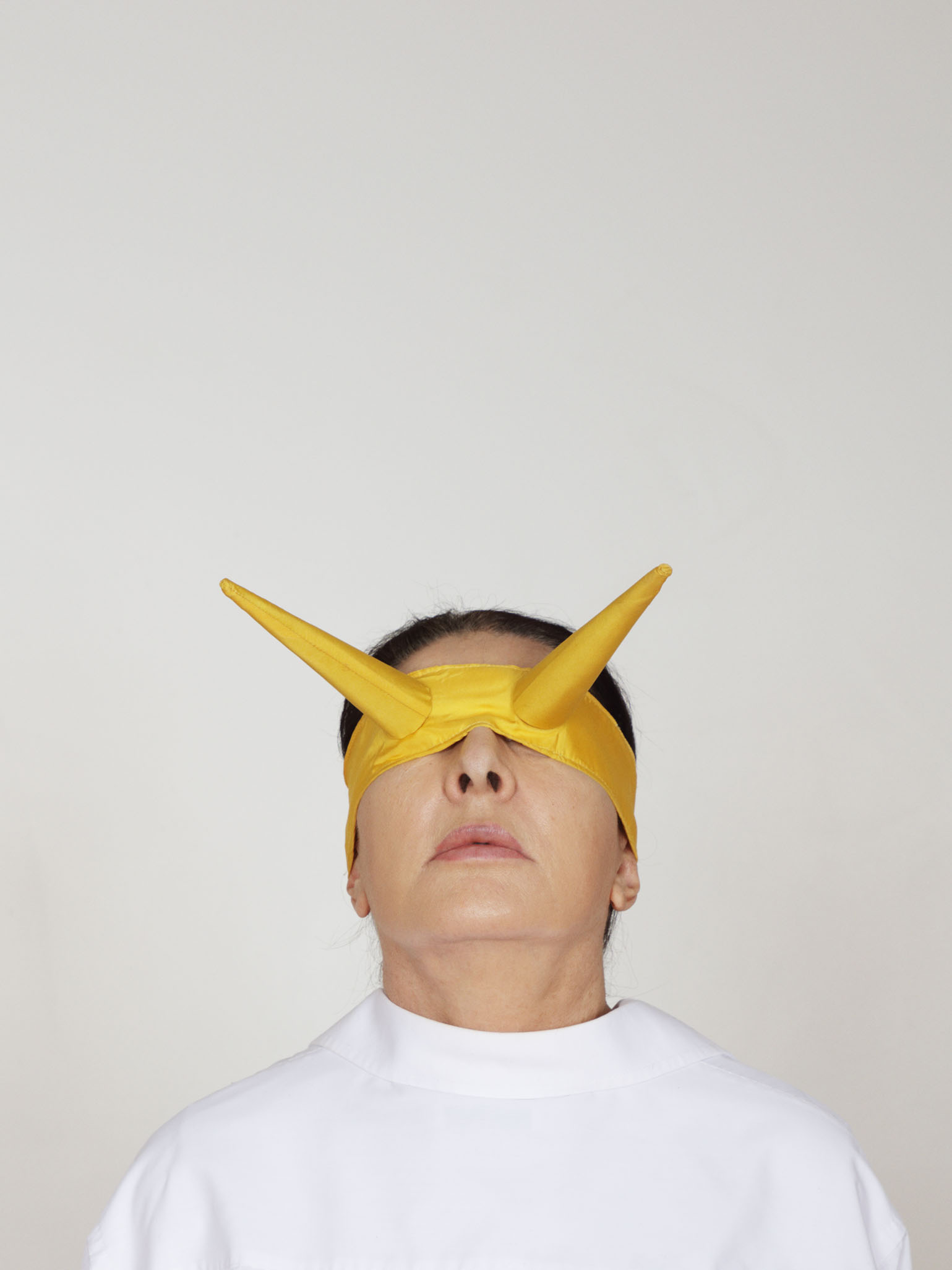
The exhibition, initiated by Meno Parkas Gallery, is one of the most important and ambitious events in the programme of Kaunas 2022. It will present in detail the work of the icon of the contemporary art world from the 1960s to the present day. The visitors will be welcome to get acquainted with the documentary material, her artistic biography and interview, the famous Manifesto, and the unique creative Method.
In the conversation with the writer Adrian Heathfield, Marina Abramović discusses the role of an artist:
„What is the function of an artist? Each artist you ask will probably have a different answer. But mine is definitely consciousness-raising. Start with yourself; change yourself. If you change yourself, you can change thousands.”

According to the director of Marina Abramović Institute Giuliano Argenziano, the exhibition partner, the exhibition will have a unique form – it will be displayed as a spectacular video installation of the selected artist’s performance documentation and films.
Arvydas Žalpys, one of the curators of the exhibition and the director of Meno Parkas Gallery, is positive that the worldview of the people of Lithuania and the surrounding region is close to the work of the Serbian artist: “From the times of the Soviet Iron Curtain, Lithuanian artists and people of culture tried to find the information about Abramović’s work in many different ways – it symbolised a brave pursuit of liberty, surpassing fear and established clichés, as well as an unconstrained expression of the artist’s identity by freeing from the well-known shackles of the Soviet system. This is why this meeting of the audience and the author is very important.”
Meno Parkas has already published the Lithuanian-language version of catalogue “The Cleaner”, the most comprehensive presentation of Abramović’s work, which is a must-read for those planning to attend “Memory of Being”. The show in Kaunas Picture Gallery will run until 31 July.
Open lecture by Marina Abramovic in Žalgirio Arena and the support for Ukraine
Even though one will have four months to see the exhibition itself, the contemporary art lovers from Kaunas, Lithuania and other countries who are most interested in the phenomenal woman and her work, ideas, and ways of thinking should get their tickets now for the artist’s meeting with her fans on 31 March at 6 pm.
Due to the much-felt anticipation, the event is planned to occur at Žalgiris Arena instead of the Picture Gallery. Tickets to the open meeting are here.
In response to the aggressive actions against Ukraine and its people, the organizers announce that part of the tickets’ incomes will support the Ukrainian cultural program in Kaunas. The Ukrainian culture program will host, support, and provide space for artists and creators, who will choose Kaunas as their temporary home during the war.
Interview with Jon Hendricks, curator of Yoko Ono’s installation Ex It
Jon Hendricks is one of the originators, researchers, and curators in the history of the Fluxus movement. He is the curator of the Gilbert and Lila Silverman Fluxus Collection. This essential collection of the Fluxus art movement began to be compiled in 1977 and was later donated to MoMA in 2008, where it is currently housed. A small part of the collection is exhibited in the George Maciunas Fluxus Cabinet at the Contemporary Art Centre in Vilnius. Hendricks organized a host of major important Fluxus exhibitions and produced pioneering scholarly publications on the movement.
Jon Hendricks is also the curator of Yoko Ono’s retrospective exhibition The Learning Garden of Freedom, opening in Kaunas this year in September.

The Fluxus art movement was crucial to the radical shift in the understanding of art in different parts of the world starting in the sixties. Fluxus manifestos, numerous artworks, and instructions on how to make them circulated intensely for many years among artists in the United States, Europe and Japan, in a network coordinated largely by the founder of the movement, architect and designer George Maciunas (Jurgis Mačiūnas), a Lithuanian émigré. Having originated in New York, the movement was directed against the rigid, elitist and ‘overly self-important’ artistic system of art schools, museums, and concerts of “serious” music, which refused any kind of levity, spontaneity and play. Yoko Ono began her artistic journey together with the Fluxus artists. You started your career as an artist.
You learned about Fluxus at the very beginning of the movement and eventually got involved as a curator and researcher, still having close links with it to this day. How did it all start and what attracted you to Fluxus?
It was a radical movement, and it was precisely its radicalism that got me fascinated. I found out about Fluxus quite early. By the way, my brother Geoffrey Hendricks was one of the Fluxus artists. At that time, I already knew other artists from the movement. But my deeper interest in it began in 1976, when Barbara Moore and I opened the Backworks bookshop. I didn’t have a job back then and the bookstore first opened in my house. We were selling contemporary artists’ books, publications and Fluxus works.
We ran the bookshop ourselves, but as you can guess, it didn’t bring much profit. Barbara and her husband Peter Moore were well acquainted with Fluxus. Peter was an important photographer and was also capturing Fluxus performances. They knew George Maciunas, who agreed to sell his Fluxus works, and we helped him. Thus, I became friends with George as well. Around the same time, Gilbert Silverman invited me to curate his and his wife Lila’s Fluxus collection. I was afraid that working in a bookshop and curating a private collection at the same time might cause some conflict, so I chose working on the collection. Gilbert was a very progressive and adventurous collector. Together we assembled a very large Fluxus collection, which is now housed in MoMA. For multiple reasons, this collection is now considered the most important Fluxus collection of all. That was the beginning of my involvement with Fluxus.
You collaborate with Yoko Ono (b. 1933) and curate her exhibitions to this day. Tell us about your experience of working with her.
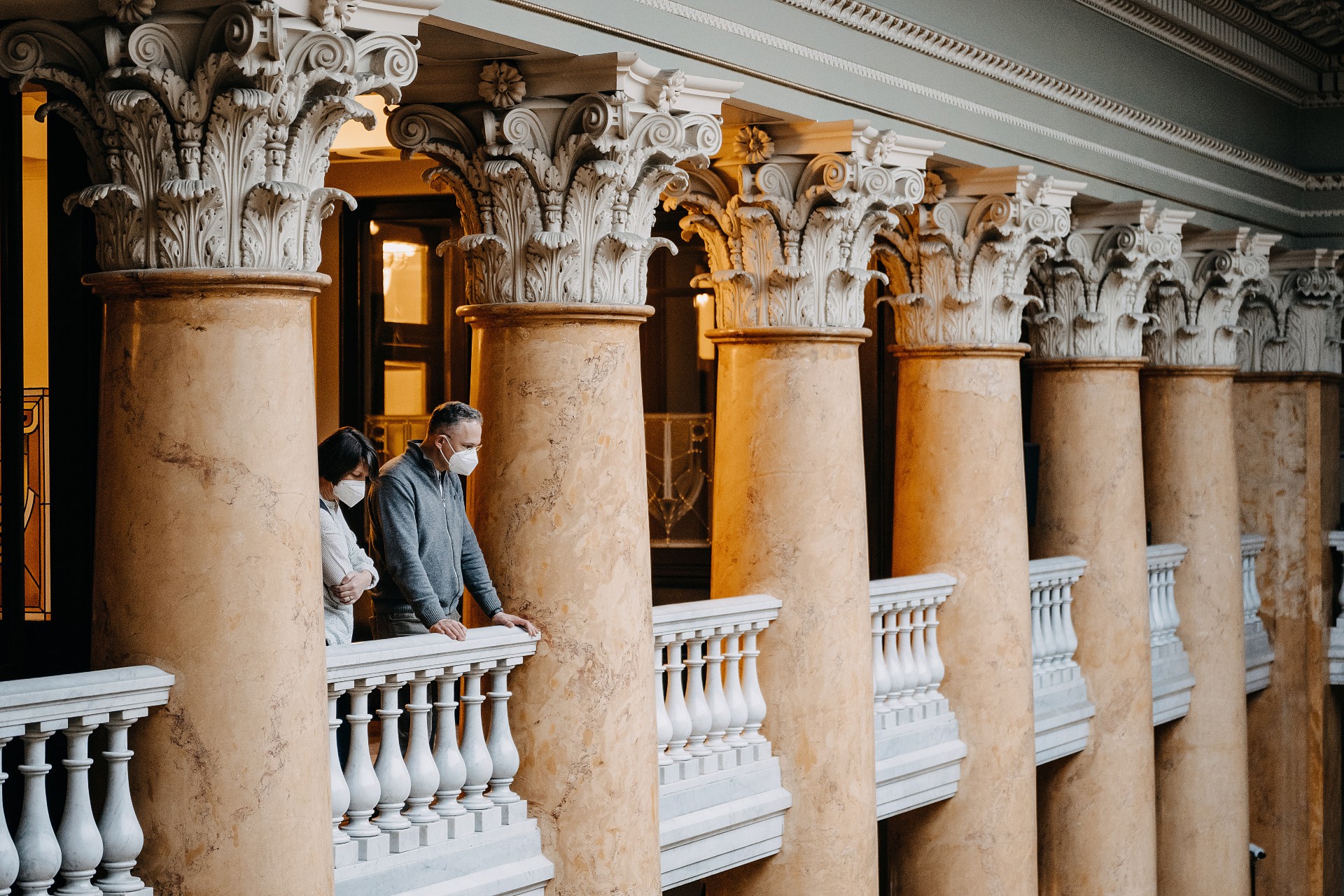
I met Yoko Ono a very long time ago, maybe in 1965 or 1966. I curated an exhibition of hers, titled The Stone, when I was working at the Judson Gallery located in a functional church of the same name. Later Yoko left for Europe, and I didn’t see her for quite a while, but when she came back our friendship continued. Working with Yoko is an incredibly wonderful experience. She is very ingenious and has a very special way of thinking. She would come up with new ideas in a flash. For instance, she was invited to participate in an exhibition in Finland related to snow and during dinner she immediately had an idea for an artwork: ICE PRISON. Melting ice liberates. She is very quick to have great ideas.
Yoko Ono’s work, related to social and political activism, touches on freedom, equality, women’s rights, and other topics that were used to promote society’s awareness. How do you see her work is presented to society today? Why is it important to get to know Yoko Ono’s work today?
It’s really a pity, but nothing has changed since her works were created and presented for the first time. Of course, there has been some progress in terms of women’s rights. But we still have a very long way ahead of us. And we can even feel it in our daily lives. When women walk down the street, they hear men whistling at them, not to mention the violence that women experience every day. One example is Yoko Ono’s piece ARISING which she first presented in Venice, with a bonfire made from a moulage of women’s bodies later lit in the centre of the piece, displayed together with a collection of real testimonials of violence and abuse experienced by women. I think this work is very powerful and we have shown it many times, continuing to collect further testimonials. This piece is no less relevant today.
The artist’s installation Ex It, now presented in Kaunas, features 100 coffins of different sizes with pine and birch trees growing out of them. Why are you starting the presentation of the artist’s work with this particular piece?
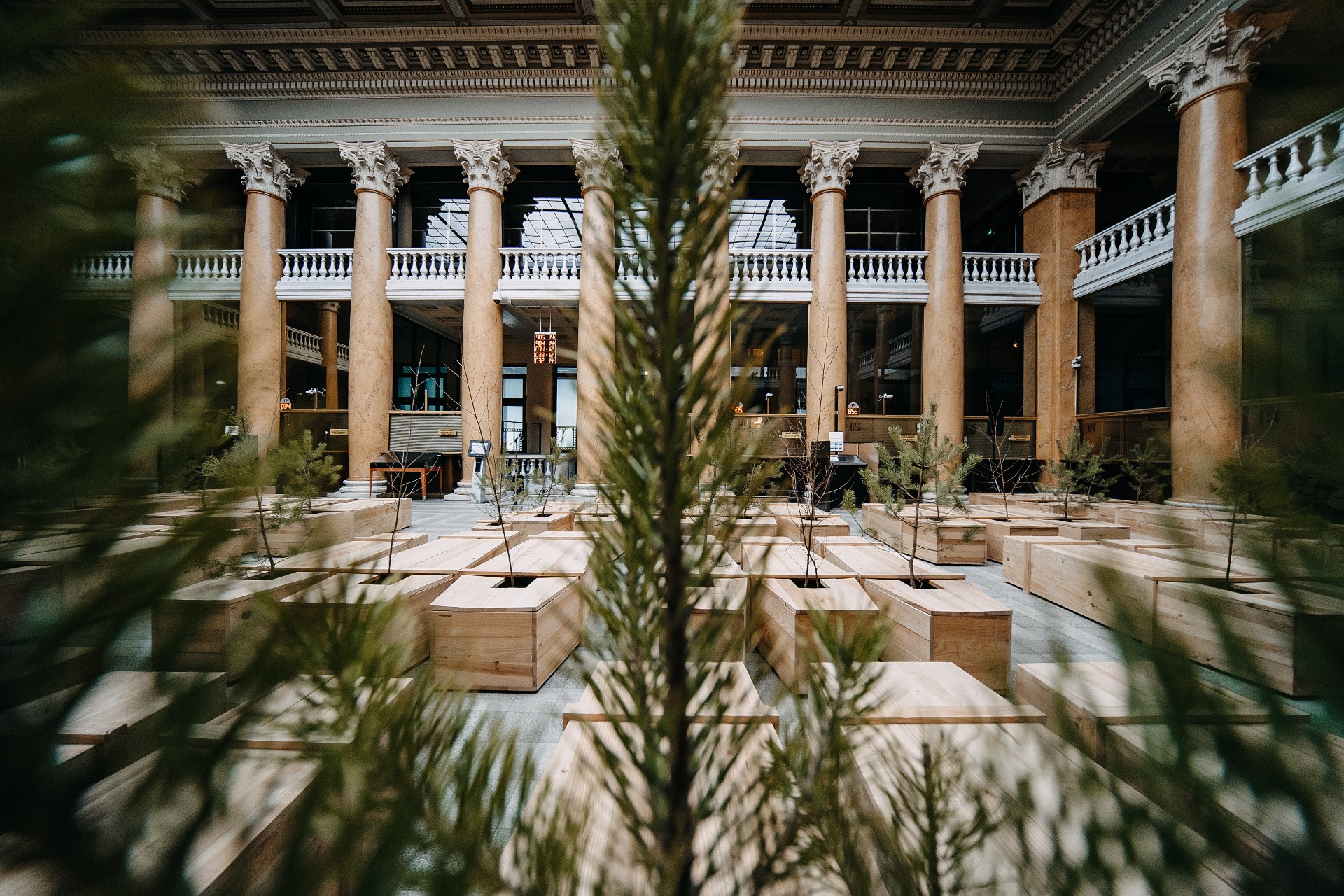
The installation Ex It illustrates a great disaster, but there is also hope here. Maybe not in this lifetime yet, but there is hope. Everybody dies, we just don’t know when I’m going to die, or when you’re going to die. Some deaths are inevitable, such as the ones that have been taken by the recent tsunami caused by a volcanic eruption. But others are avoidable. For instance, deaths caused by wars. This installation will still be important for a long time to come. Maybe people will associate it with the tsunami I mentioned, maybe with other natural disasters, maybe with the current state of the world, maybe with wars. Yoko doesn’t want to explicitly state and dictate what people should see in this installation, what kind of disaster it implies. As in all of her works, there is a lot of space for the viewer’s imagination.
How did you decide to exhibit this installation in the premises of a bank? The actually functioning bank and the banking operations happening in the same space as the installation create a strong additional field of associations and meanings for the piece.
This space was suggested by CAC director Kęstutis Kuizinas, although the initial idea was to place it elsewhere. It is usually exhibited in gallery spaces, but we have also presented it in a church and outside a cemetery. The bank space adds even more different meanings. I think this space is very suitable for the installation. Equally important is the beautiful architecture of the building. But at the same time, I believe that any space can be fitting to present this installation. And all spaces would bring their own meanings because all spaces are charged with different symbols. The installation will change a little bit soon when the trees start leafing out. And after the installation closes, it will continue living, as the trees spread across the city. We will plant them ourselves or invite people to plant them in their parks and gardens.
Dovilė Grigaliūnaitė


